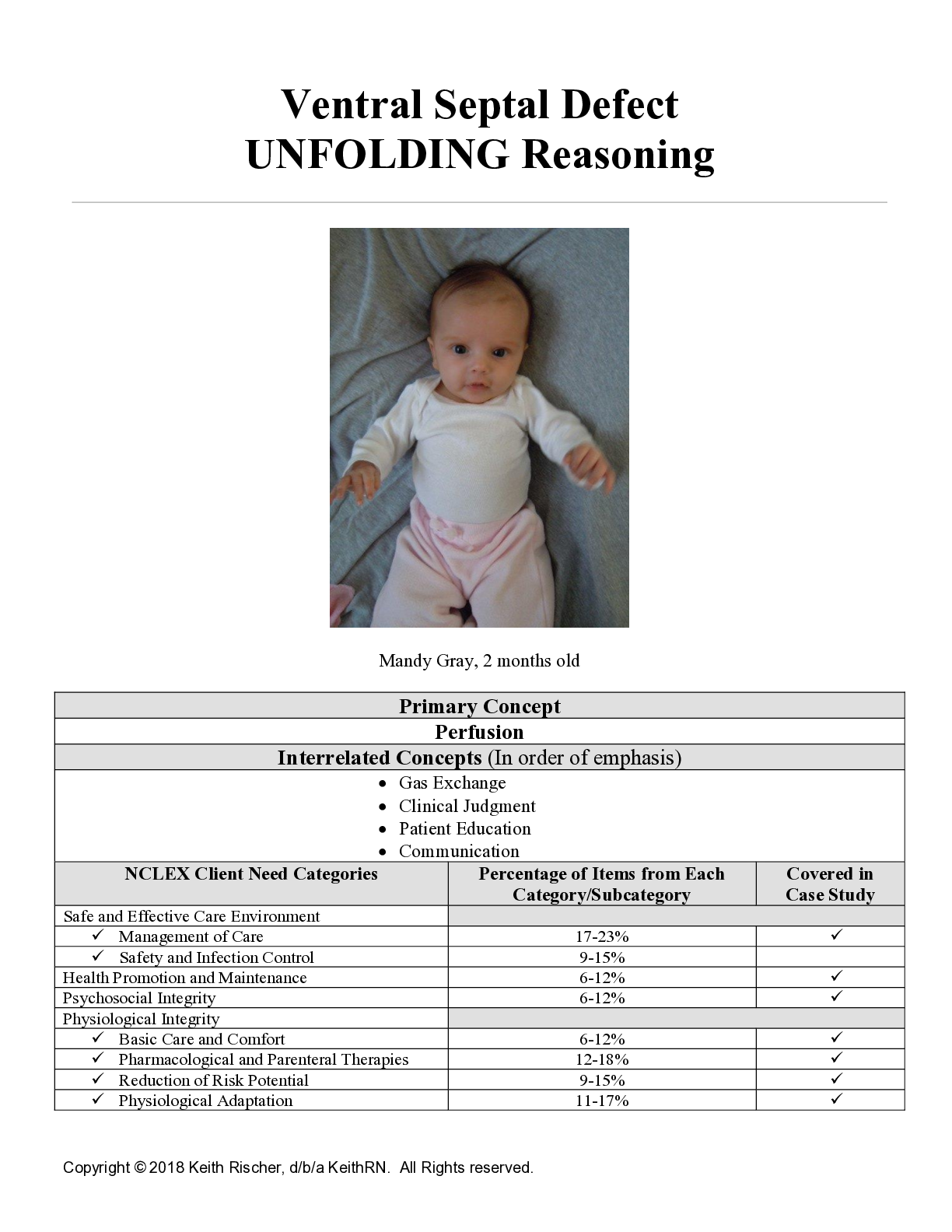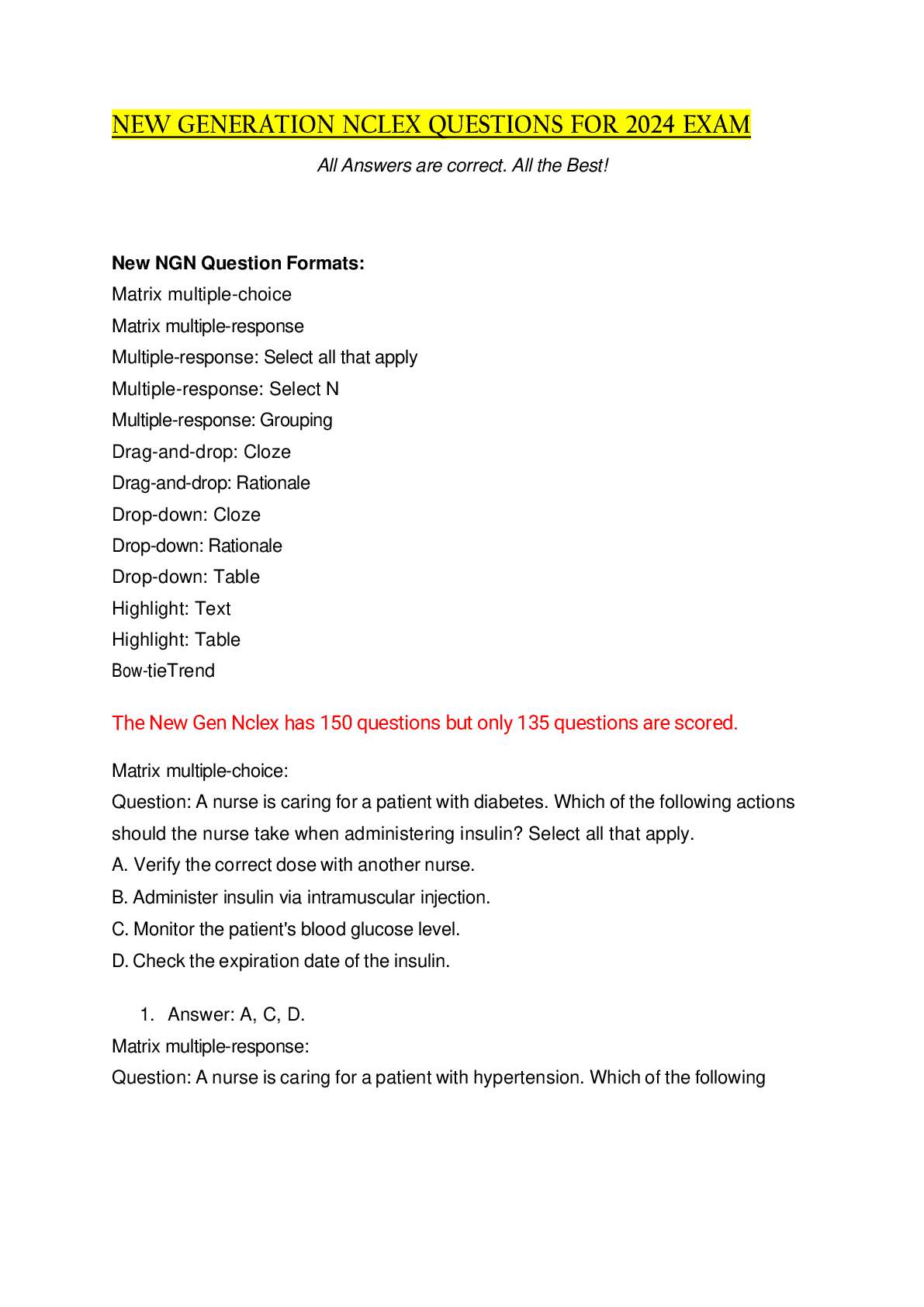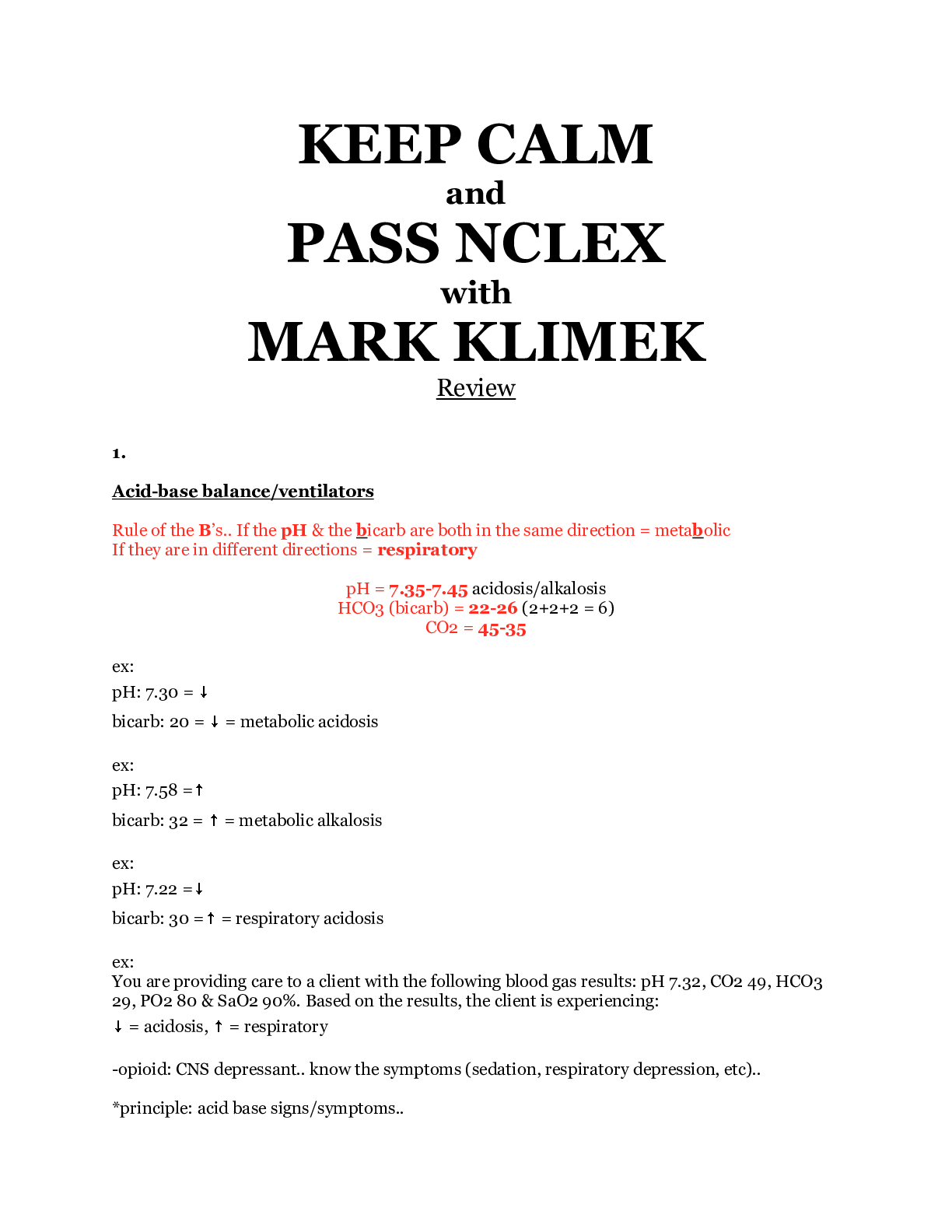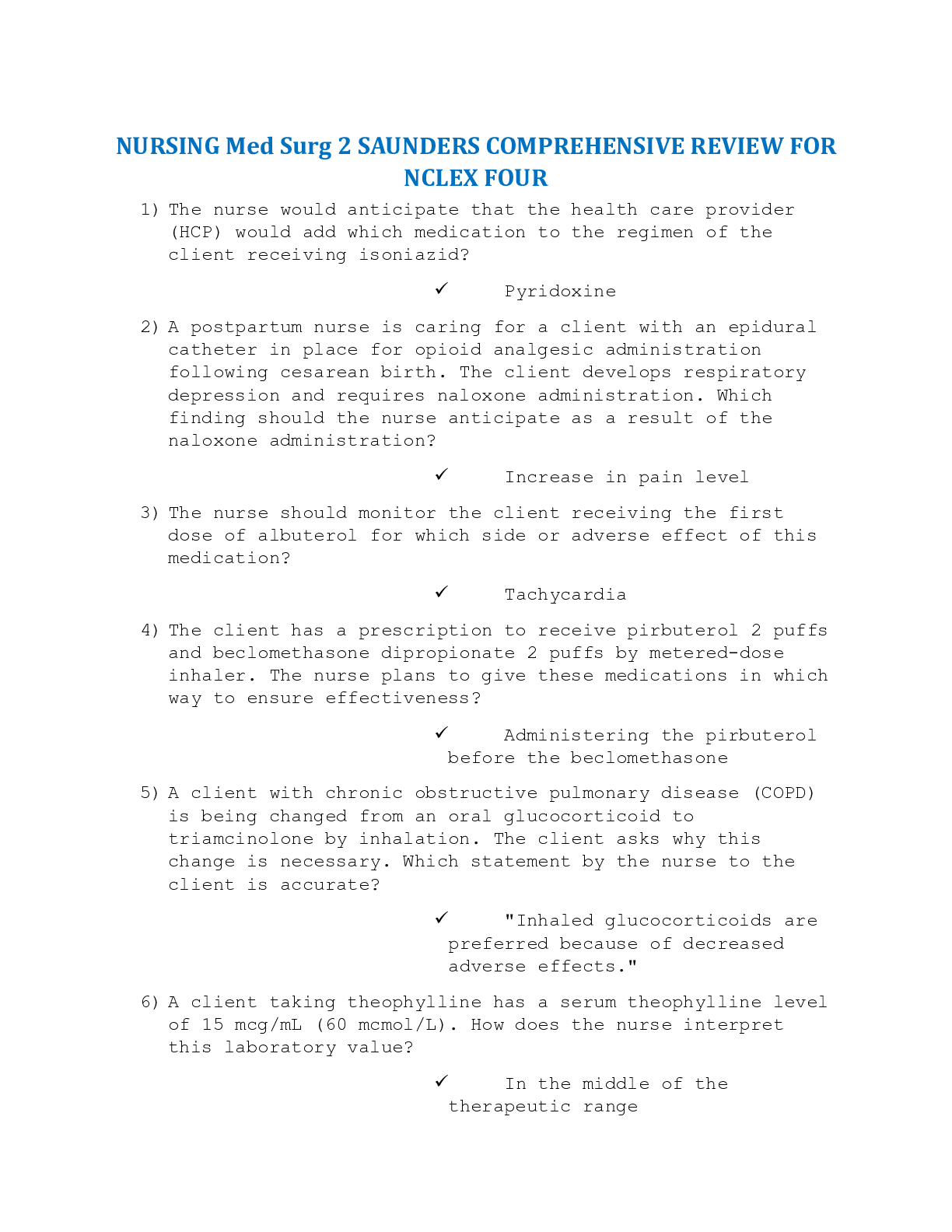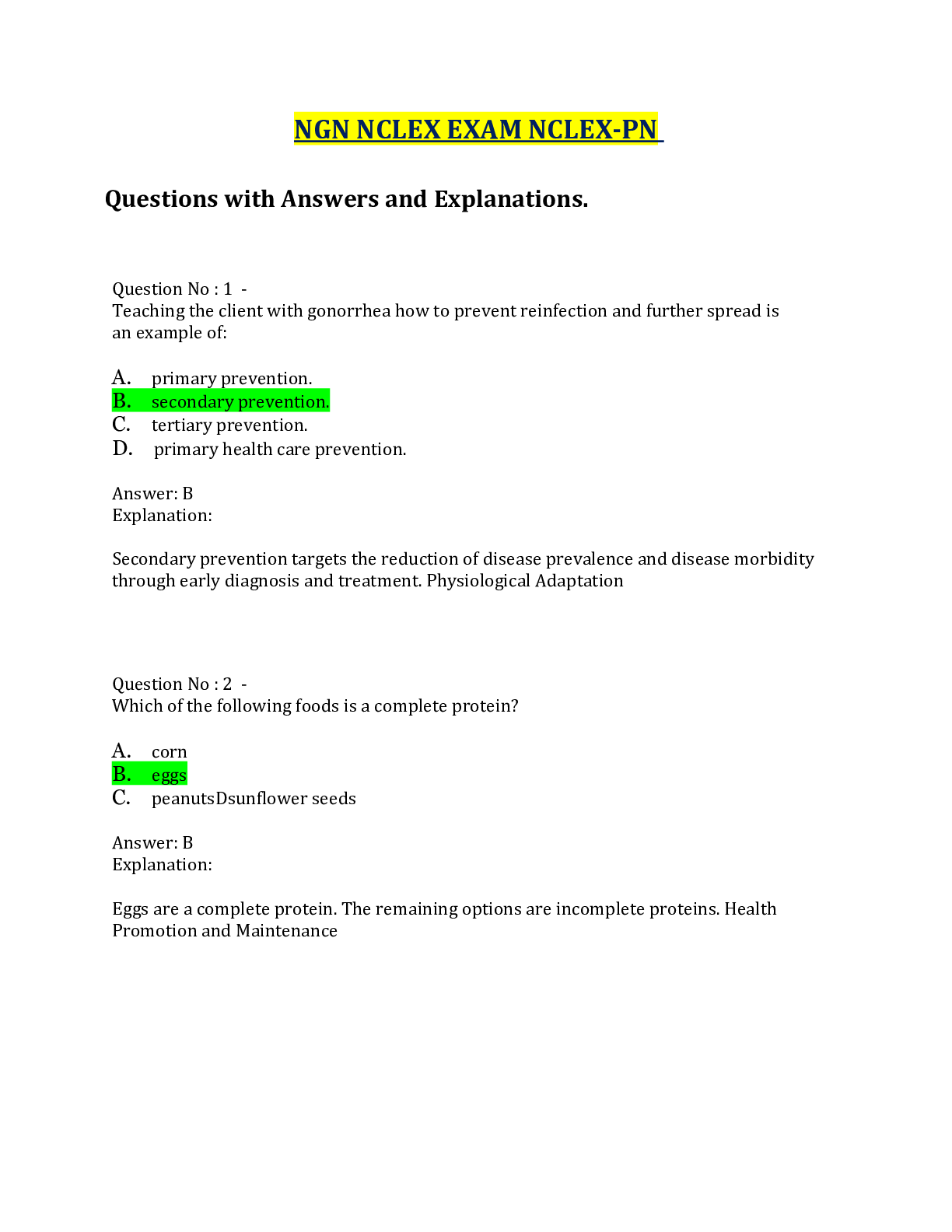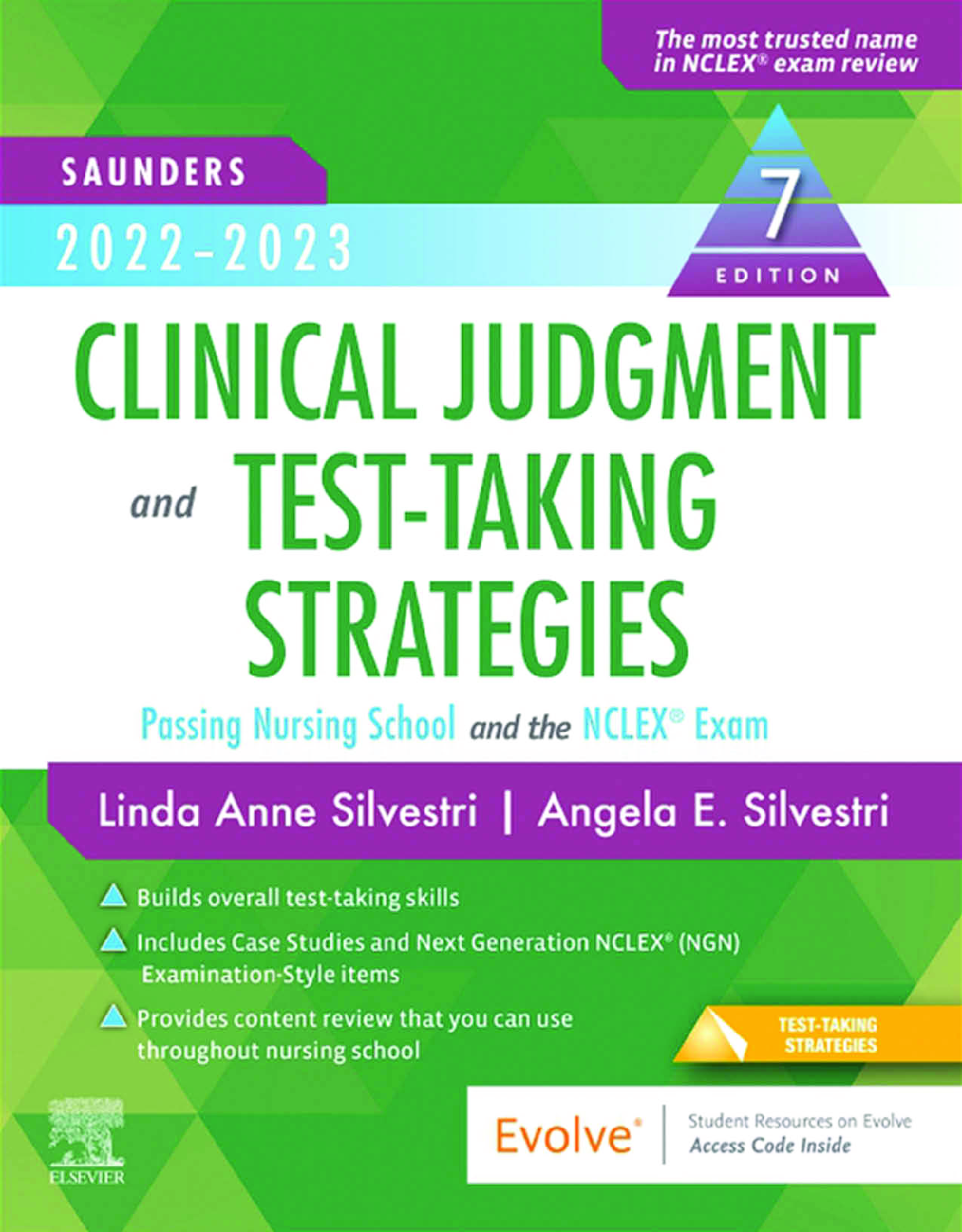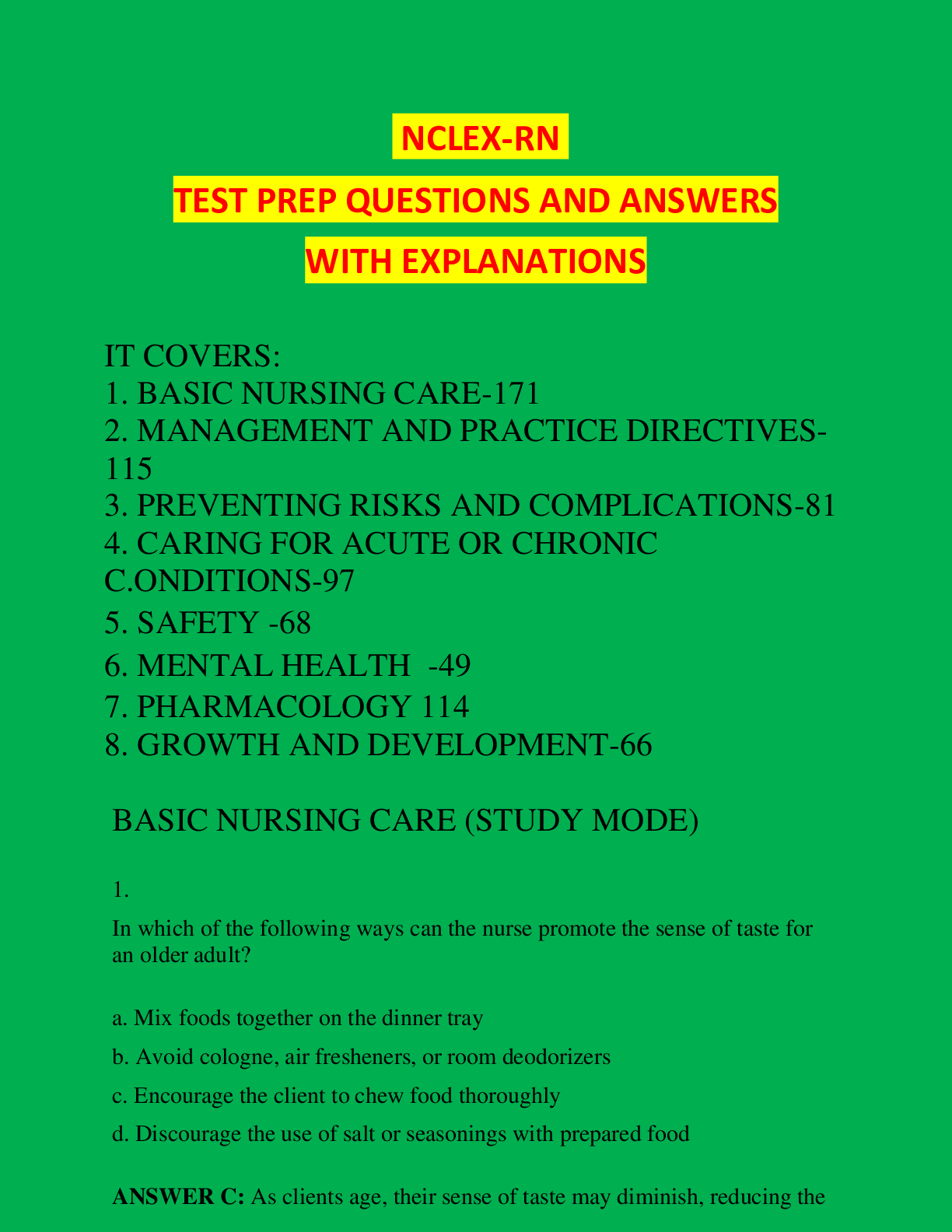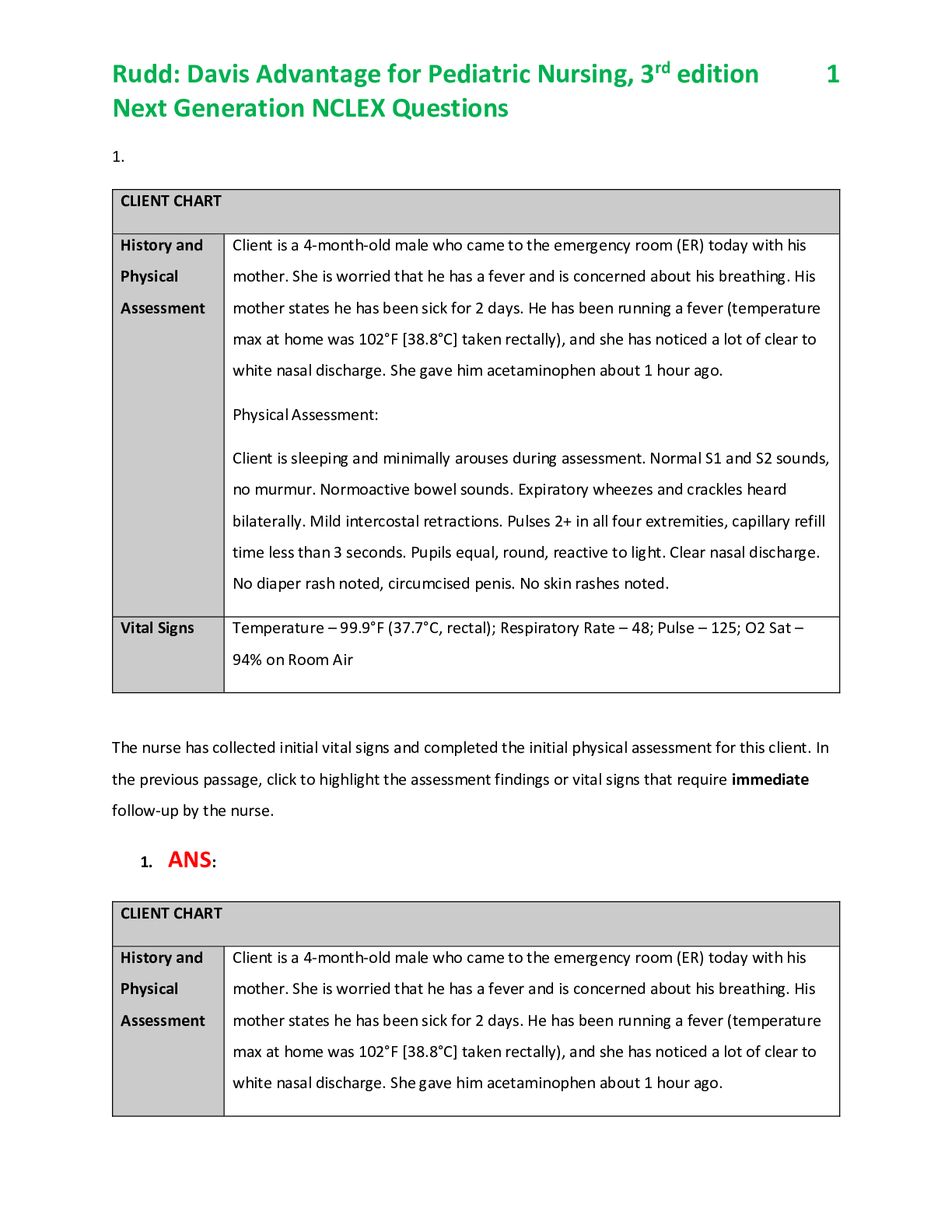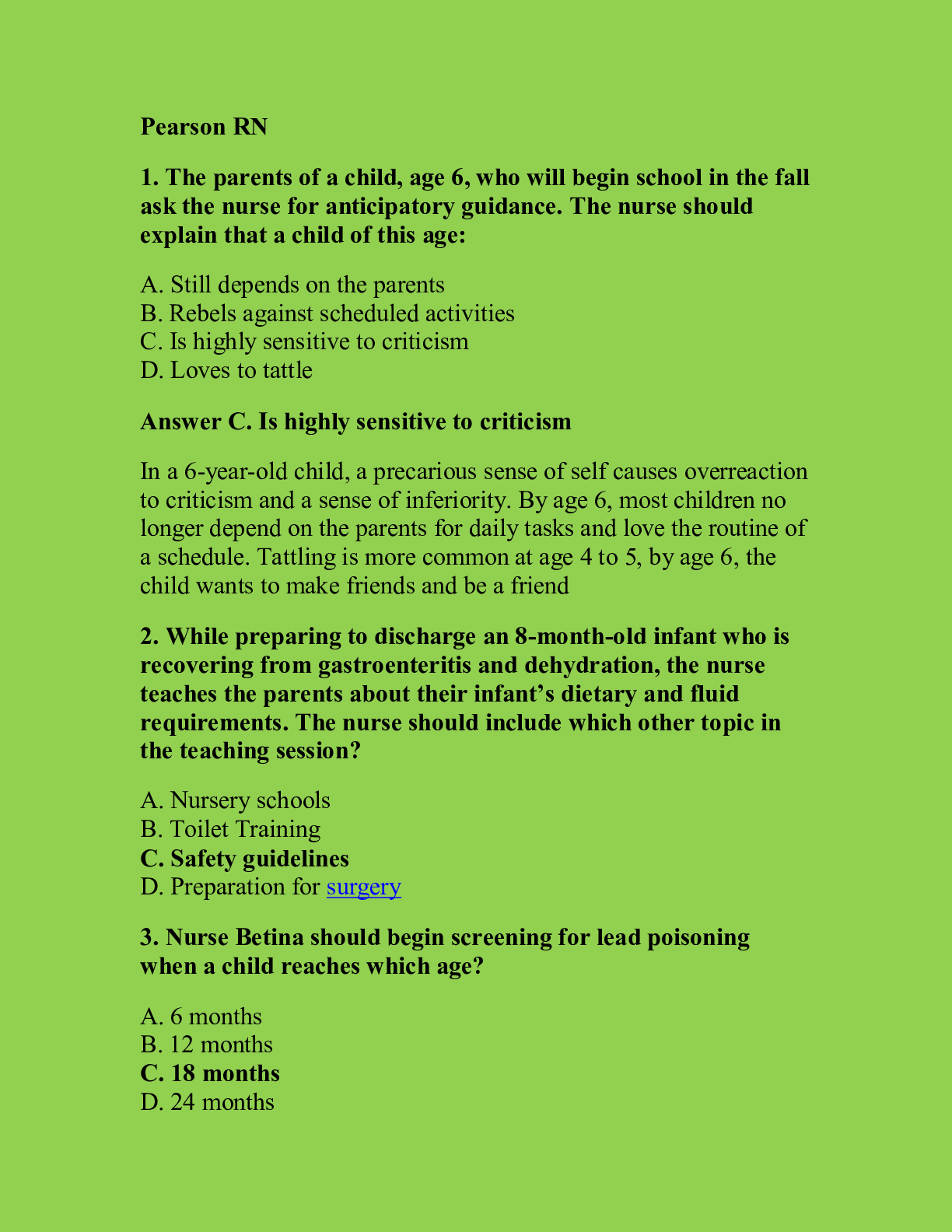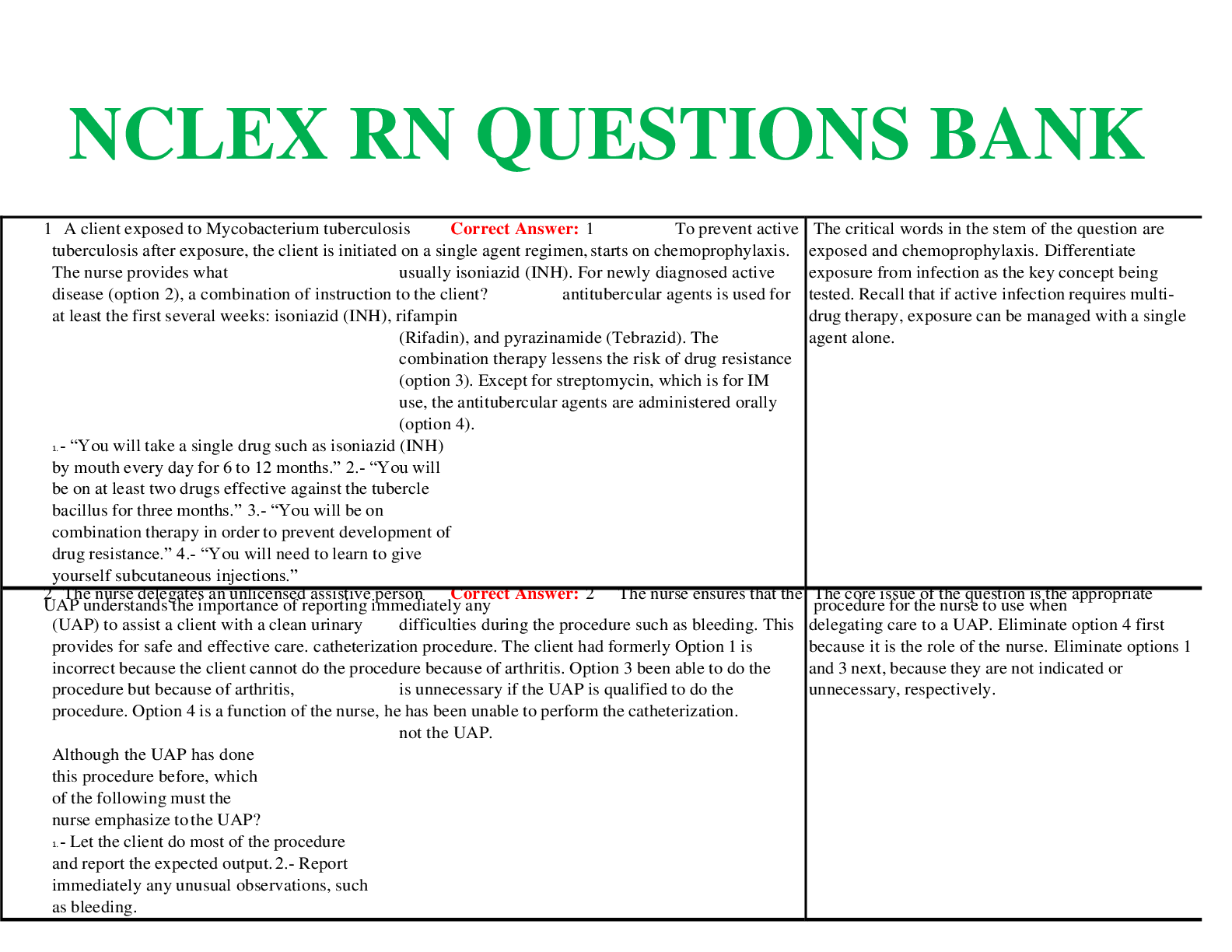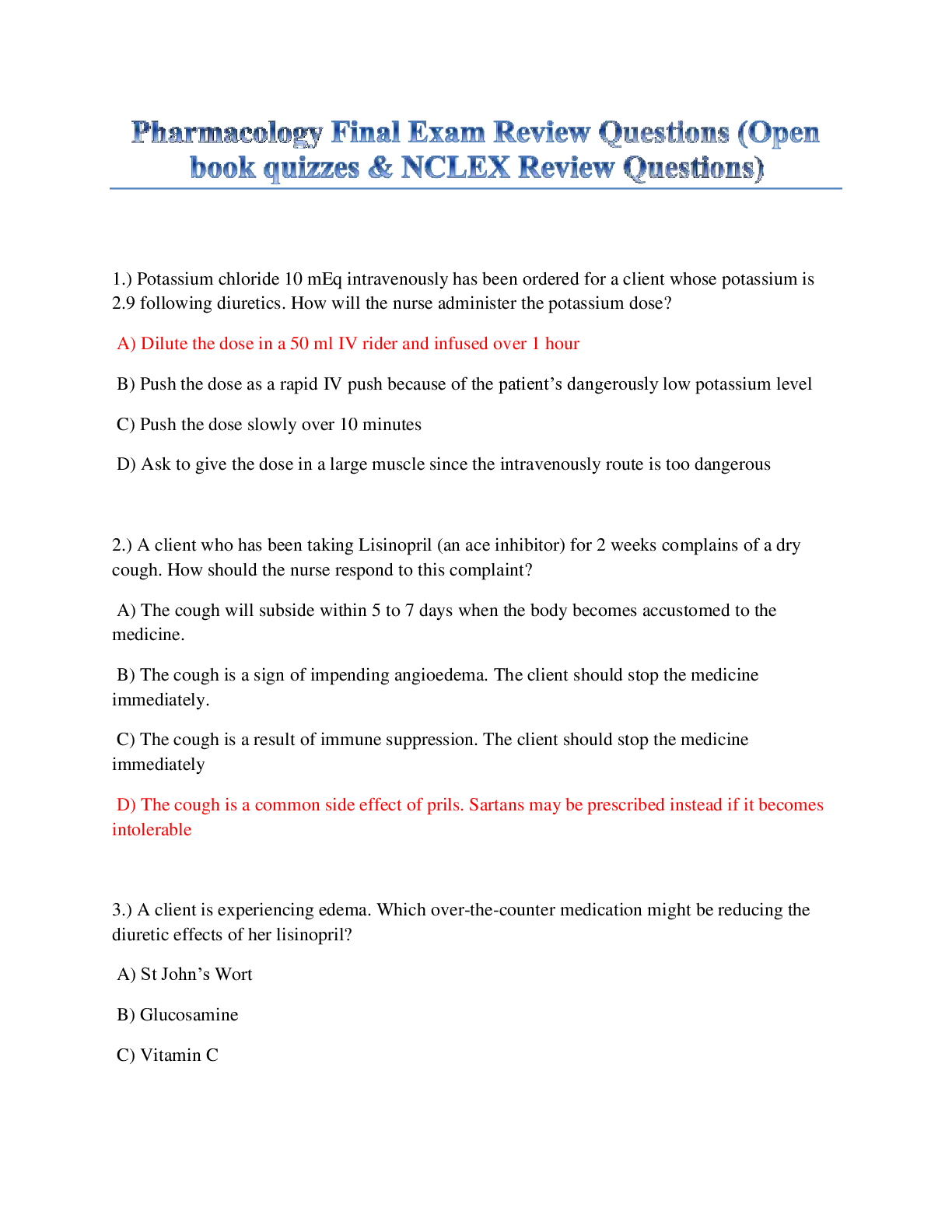*NURSING > NCLEX > NCLEX-RN Practice Exam 1 (GRADED A)165 Questions and Answers elaborations | 100% Correct solution. (All)
NCLEX-RN Practice Exam 1 (GRADED A)165 Questions and Answers elaborations | 100% Correct solution.
Document Content and Description Below
NCLEX-RN® Practice Exam 1 Total Questions: 165 About This Test This printable version does not include all the features and functionality of the online version and may offer fewer questions. For... a complete experience, take the online version. © 2021 EBSCO LearningExpress 1. A client diagnosed with pneumonia states difficulty in producing a productive cough. The nurse should instruct the client to complete which of the following to maintain airway clearance? decrease fluid intake B. pursed-lip breathing technique splint the chest when coughing D. deliver oxygen via nasal cannula 2. A client requiring prolonged mechanical ventilation has the following arterial blood gas (ABG) results: pH: 7.49; PaO2: 85 mm Hg; PaCO2: 30 mm Hg; HCO3: 25 mEq/L. The nurse interprets these results as metabolic acidosis. B. metabolic alkalosis. respiratory acidosis. D. respiratory alkalosis. A client is diagnosed with angina pectoris. The nurse has instructed the client on the proper use of a nitroglycerin sublingual. The nurse also informs the client that which of the following adverse effects may be caused by this medication? flushing, dizziness, headache, and pedal edema B. headache, hypotension, dizziness, and flushing nausea, vomiting, depression, fatigue, and impotence D. sedation, nausea, vomiting, and constipation A nurse is teaching a client how to administer Proventil to the client’s child using a metered dose inhaler with a chamber. The nurse explains that the medication should be administered just prior to the child’s inhaling. B. as the child is inhaling. as the child is exhaling. D. just after the child exhales. 5. A nurse is working in an alcohol rehabilitation facility. A client she is caring for asks for a referral to a support group in the community that can help him maintain his sobriety. How should the nurse respond? "Here are the phone numbers and meeting locations for Alcoholics Anonymous and SMART Recovery." B. "I will help you enlist support from your loved ones." "I will refer you to a primary care physician knowledgeable in caring for alcoholics." D. "You will need to have your friends’ support." 6. A nurse is caring for a client who is scheduled for heart surgery the following week. The client wishes to appoint her spouse to make medical decisions for her in the event that something happens during the surgery. Which document should the nurse suggest to the client? Living will B. Health care proxy Do not resuscitate order D. Power of attorney 7. A nurse is observing a student perform care for a client with hearing aids in both ears. Which student action should be corrected by the nurse? Exaggerating mouth movements when speaking to the client B. Standing directly in front of the client when speaking with the client Keeping hands away from the face while speaking with the client D. Making sure that the room light is on before administering care 8. A nurse is caring for an elderly client who lives alone. Upon assessment, the nurse notes that the client has poor hygiene. Which is the most appropriate referral for this client? Adult protective services B. Primary care physician Social worker D. Psychologist 9. A client is admitted to the orthopedic unit with a diagnosis of acute osteomyelitis. The osteomyelitis developed after an open fracture of the left femur. Which of the following nursing measures should the nurse anticipate completing in the treatment of this client? administering large dosages of IV (intravenous) antibiotics B. ambulating the client up and down the hallway twice daily maintaining the client’s NPO (nothing by mouth) status D. providing the client with oral antibiotics four times daily A client has just returned to the nursing unit following a left below-knee amputation as a result of arterial insufficiency. Which of the following actions should the nurse include in the postoperative care plan? Apply heat to the stump every four hours for 20 minutes. B. Elevate the stump for the first 24 hours postoperatively. Maintain the client on complete bed rest. D. Remove the stump’s pressure dressing 12 hours postoperatively. A nurse is performing a fundal assessment on a client two days after delivery. Where in the abdomen would the nurse expect the fundal height to be located? A nurse is caring for a client with free-floating anxiety. Which of the following symptoms would the nurse expect the client to exhibit? chronic worry or fear B. fear about what will happen next repetitive behavior D. sense of impending doom The nurse is caring for a client with a central venous access device. Which action should the nurse include in the client’s care plan? Change the catheter every three days. B. Flush each lumen with heparin solution daily. Change the occlusive transparent dressing once each day. D. Use aseptic techniques when caring for the device. The nurse manager is made aware of conflict between two nurses. After speaking with the two nurses, the manager notes that there are no acceptable options to either person. Which stage of conflict is occurring? Avoidance-Avoidance B. Approach-Approach Approach-Avoidance D. Resolution A six-year-old child is brought to the emergency room with an ear infection. As the assessment is being completed, the nurse notices that the child has bruises that encircle his legs just above the ankles and his arms just above the wrist. The child’s caregiver has no explanation for the bruises. The nurse should confront the caregiver regarding the suspected abuse. B. discuss stress reduction with the caregiver. keep the caregiver away from the child. D. notify the appropriate authorities of suspected child abuse. A client seeks medical attention in the emergency department after developing acute abdominal pain two days prior. Which of the following actions by the nurse helps ensure accurate auscultation of the client's bowel sounds? auscultating the abdomen by utilizing the bell of the stethoscope B. listening for one full minute in each quadrant to confirm absence of bowel sounds pressing the stethoscope gently but deeply into the abdomen D. requiring that the client empty his or her bladder prior to auscultating the abdomen A child is admitted to the hospital with appendicitis. Based on this diagnosis, the nurse would expect to find which of the following while completing the admission assessment? abdominal swelling B. decreased bowel sounds right lower quadrant abdominal pain D. right upper quadrant abdominal pain A nurse is assessing a 38-week-pregnant client during a routine prenatal visit. The client states that she is tired because she has spent the last two days cleaning the house, preparing the nursery, and buying needed items for the baby. The nurse realizes these actions as which of the following? the latent stage of labor B. powers of labor signs of false labor D. signs of impending labor A nurse is assigning beds to four new clients being admitted to the cardiac telemetry floor. Which of the following clients would most appropriately be assigned to the bed at the end of the hall, away from the nurses' station? a 27-year-old client with unstable hyperthyroidism who has a heart rate of 110 beats per minute B. a 40-year-old client with mitral valve prolapse in sinus rhythm that is newly diagnosed with diabetes a 55-year-old client in sinus rhythm transferring from the ICU three days post- coronary artery bypass grafting (CABG) D. a 75-year-old client with sinus tachycardia who is confused and agitated three days following a prostatectomy A nurse is caring for a child with Tetralogy of Fallot. While attempting to administer the child’s medication, the child begins to cry and becomes dyspneic and cyanotic. The nurse should place the child in which position? left lateral B. knee-chest sitting with head of bed elevated at a 90-degree angle D. standing A client is receiving intravenous (IV) heparin for treatment of deep vein thrombosis (DVT). Which of the following precautions should the nurse incorporate into the client’s plan of care as a result of receiving IV heparin? Check the client’s activated partial thromboplastin time (aPTT) values daily to monitor for therapeutic anticoagulation. B. Establish a separate intravenous infusion line for the administration of other prescribed medications. Have a vitamin K injection available at the client’s bedside as an antidote to potential heparin overdose. D. Protect the heparin infusion from light by placing an opaque cover over it to prevent discoloration of the medication. A client being treated for cervical cancer receives a sealed radiation implant. When caring for this client, the nurse implements care based on which of the following facts? The client should be maintained on complete bed rest with bathroom privileges only. B. The client is considered to be radioactive for 10 days after implant removal. The client's urine, feces, and vomitus are considered to be highly radioactive. D. Soiled linens should remain in the client’s room until after the client is discharged. The parent of a preschooler contacts the physician’s office to inquire about her child’s flu- like symptoms. The nurse knows that to decrease the risk for Reye’s Syndrome, a child with flu-like symptoms or chickenpox should not be given aspirin. B. antihistamines. cough medicine. D. Tylenol. A nurse is developing a plan of care for a non-pregnant client who is a gravida 2 para 1. Based on this information, the nurse develops the plan knowing that the client’s pregnancy history includes one pregnancy, one miscarriage. B. one pregnancy with twins delivered. two pregnancies, one of which was delivered at or after the age of viability. D. two pregnancies, one of which was ended by elective abortion. A nurse is caring for a client with confusion secondary to a urinary tract infection. The client has just had a central intravenous (IV) line placed by the physician for antibiotic administration. Following the procedure, it is important for the nurse to complete which of the following? Administer Ativan (lorazepam) as needed for agitation and anxiety. B. Discuss with the client the importance and purpose of the central line. Place soft restraints on the client’s wrists to prevent dislodgement. D. Secure the line per policy and cover the line with gauze to disguise it. The nurse is caring for a client who is admitted for abdominal pain with unknown origin. The client reports severe pain and requests pain medication. The client has orders for both Tylenol and Percocet in the chart. Which action should the nurse perform first? Administer Tylenol as ordered B. Administer Percocet as ordered Assess the client’s pain D. Document the pain level in the chart A three-year-old is brought to the physician’s office because of an earache. To perform the otoscopic exam, the nurse should gently pull the pinna down and outward. B. down and back. up and back. D. up and outward. The nurse is caring for a client who was recently diagnosed with terminal cancer. The client asks for a lethal dose of morphine because of a fear of suffering at the end of life. Which is the best response by the nurse? “I’m not allowed to do that.” B. “Let me speak with the physician about getting an order.” “I can’t administer the medication to you, but if you saved your pills, you might have enough.” D. “I can’t do that but we will make sure that you are comfortable during the dying process.” A nurse receives an order from the provider that states “MS 4mg IV prn severe pain.” Which is the best action by the nurse? Administer morphine sulfate as ordered. B. Contact the provider for a corrected order. Speak with the nurse manager for clarification. D. Contact the pharmacy about drug abbreviations. A client presents to a community clinic with constipation lasting 5 days. Which intervention should the nurse recommend first? Go to the emergency department for disimpaction. B. Increase fluids to 1L per day. Use an over-the-counter enema or suppository. D. Decrease fiber to soften stool. A nurse is assessing a 13-month-old infant who has been vomiting for the past three days. The infant has become lethargic and has only had one wet diaper in the past eight hours. The nurse expects that the infant’s anterior fontanel will be bulging. B. closed. firm. D. sunken. A nurse is reviewing dietary restrictions with a client diagnosed with Crohn’s disease. Which of the following statements made by the client indicates that further teaching is required? "Avoidance of carbonated and caffeinated beverages is highly encouraged." B. "Eliminating spicy and fatty foods from my diet is now necessary." "If I include milk and milk products in my diet, my Crohn’s will flare up." D. "I will include high-fiber foods in my diet such as fruits, vegetables, and whole grains." A neonate that was born with trisomy 21 has a poor suck reflex and requires tube feedings. The mother expresses concern about forgetting how to perform the tube feedings when she gets home. As the nurse is planning for the infant’s discharge, the nurse should consider placing a home-health nursing referral. B. placing a lactation-consultation referral. scheduling a pediatrician appointment for the infant the day after discharge. D. telling the client that she will remember how to perform the tube feedings. A nurse is conducting a home visit to a mother and four-month-old infant. The nurse recognizes that the client needs additional instruction on providing the infant with a safe sleeping environment when she notices which of the following? a pacifier in the infant’s mouth B. no crib bumpers a large stuffed teddy bear in the crib D. the infant sleeping on its back A nurse is measuring the head circumference of a neonate. On what anatomical landmark should the nurse place the tape measure? A nurse is caring for a quadriplegic client who is at risk for developing pressure sores and ulcers. The nurse recognizes that which piece of equipment impedes circulation to the area it is intended to protect? donut- or ring-shaped cushions B. floatation gel pads and cushions pressure-release wheelchairs D. specialty mattresses A nurse is preparing a client for surgery and has administered a benzodiazepine to induce drowsiness and relieve anxiety before the procedure. Upon reviewing the chart, the nurse notes that the surgical consent form was not signed. Which is the best action by the nurse? Notify the surgeon. B. Have the client sign the consent form. Flag the form to be signed after the client wakes up from anesthesia. D. Contac the client’s next of kin to sign the consent. A nurse is assessing a six-month-old infant. The nurse knows that according to Eric Erickson, if the infant’s basic needs are not met by its caretakers, the infant is at risk for developing doubt. B. isolation. mistrust. D. trust. The nurse is caring for a pregnant woman who has been placed on bedrest for several months in order to prevent preterm delivery. Which instruction should be included in the teaching? Decrease fiber intake. B. Flex and extend the feet and ankles several times daily. Avoid changing positions while in bed. D. Reduce fluid intake to avoid nighttime urination. The nurse receives a phone call from a client’s sister who asks about how a scheduled surgery went. What is the best response by the nurse? “It went great. He should be back later today.” B. “The surgeon said there were no complications.” “I’ll transfer you to the post anesthesia care unit so you can speak with his nurse.” D. “We aren’t able to provide any client information over the phone.” A nurse is caring for a female client newly diagnosed with anemia. The nurse will encourage the client to include which of the following iron-rich foods in her diet? beef, chicken, and green peas B. luncheon meats and canned vegetables nuts, salmon, and potatoes D. strawberries, broccoli, and oranges A nurse has several tasks that are waiting to be completed. Which can be delegated to a nursing assistant? Assessing a client’s pain level B. Measuring fluid intake and output Administering Tylenol to a client requesting a pain reliever D. Performing a sterile dressing change A nurse has witnessed a client sign a surgical consent form. Once the provider steps out of the room, the client asks the nurse to explain everything that was just discussed and if there are any other options. Which should be the first action by the nurse? Notify the provider to come back and explain the procedure. B. Sign the witness section of the form. Document the interaction. D. Answer the client’s questions. A nurse is teaching a client who is newly diagnosed with asthma how to correctly use a metered dose inhaler without a chamber. Client understanding will be evident if the client does which of the following? avoids inverting or shaking the metered dose inhaler B. holds his or her breath for at least ten seconds following inhalation inhales through the nose during activation of the device D. takes two rapid inhalations during one breath A male client is admitted to the Neurological ICU after sustaining a head injury from a hiking accident. The client is unconscious, and his pupils are nonreactive. The nurse caring for this client recognizes that which of the following interventions is contraindicated? administering a barbiturate B. elevating the head of the bed performing a lumbar puncture D. placing the client on a mechanical ventilator A nurse has several clients waiting for care. Which client needs to be seen first? A client who is ready for a scheduled dose of pain medication B. A client who is anxious about surgery tomorrow A post-operative client with a blood pressure of 87/42 D. An elderly client who needs help ambulating to the bathroom A nurse is providing instructions on eyedrop administration to a client. One eyedrop is prescribed to be given in the left eye. The nurse recognizes further instructions are needed when the client completes which of the following during the return demonstration? lies supine, pulls down the lower lid, and puts the drop in the lower lid B. lies supine, pulls up on the upper lid, and puts the drop in the upper lid lies with head to right, puts the drop in the inner canthus, and turns head to the left while blinking D. tilts the head back, pulls down on the lower lid, and puts the drop in the lower lid On post-delivery day one, a client who experienced pre-eclampsia during her pregnancy is receiving IV magnesium sulfate. The nurse caring for the client wants to be sure that the antidote for magnesium-sulfate toxicity is readily available. The nurse should look for which medication? calcium gluconate B. Narcan Nubain D. prostiglandin E A nurse receives a telephone order for intravenous fluids for a client. What should the nurse do first? Hang the ordered fluids. B. Refuse to hang the fluids until given a written order. Document the phone call and telephone order. D. Read back the order to the ordering physician. A nurse is admitting a client who has a cellulitis infection. The client states that he has a healthcare proxy. Which is the best response by the nurse? “You don’t need a healthcare proxy. You only have a minor infection.” B. “I’ll let you know if it becomes necessary to have it in your chart.” “I’ll make a copy of it, place it in your chart and let your doctor know.” D. “You’ll just need to let your doctor know about your wishes.” A nurse is assessing a neonate’s head and notices that there is edema of the soft tissues. The edema crosses over the suture lines. The nurse should document this as caput succedaneum. B. cephalhematoma. crowning. D. molding. A client presents to the emergency department stating, "I just don’t feel right." The triage nurse notes the client’s vital signs are stable and obtains the following ECG tracing. Which of the following nursing actions would be the most appropriate? Apply 4 liters of oxygen via nasal prongs and complete a 12-lead ECG. B. Interpret the tracing as normal sinus rhythm and complete the triage. Take the client to a room promptly and notify the physician right away. D. Start an IV line and administer two 81-mg oral aspirins (acetylsalicylic acid). A nurse is teaching a class on fetal development. She explains that after fertilization, the blastocyte travels down the Fallopian tubes and then implants into the uterus. The nurse should explain that implantation usually occurs how many days after fertilization? 1–4 B. 3–7 7–10 D. 10–14 A client is being treated in a medical-surgical unit for cellulitis of the left lower extremity. The nurse caring for the client reviews the physician’s orders expecting which of the following therapies to have been ordered? alternating hot and cold compresses B. cold compresses to the lower leg intermittent heat lamp treatments D. warm compresses to the lower leg Two days following a myocardial infarction (MI), the client states, "It was just a little chest pain. As soon as I get out of here, I’m going on vacation." Which nursing intervention is appropriate to include in the client’s care plan? Allow the use of denial as a coping mechanism until the client starts asking questions about the MI. B. Begin teaching the client about the normal functions of the heart to improve his understanding of the MI. Have family members or a significant other encourage the client to continue planning for the vacation. D. Redirect the client. Implement reality orientation by reminding the client several times a day about the MI. A client has developed digitalis toxicity. The client is stable. Which of the following actions would be considered most appropriate in this situation? administering activated charcoal B. administering atropine preparing the client for hemodialysis D. symptomatic treatment and time A client with cirrhosis is receiving Cephulac (lactulose). During the client’s routine assessment, the nurse notes increased confusion and asterixis. The nurse should complete which of the following based on these findings? Assess for gastrointestinal (GI) bleeding. B. Evaluate the client’s serum bilirubin levels. Hold the client’s next dose of lactulose. D. Increase the client’s dietary intake of protein. After delivery, a nurse is administering vitamin K to a neonate. The order is to give 1 mg (milligram) of AquaMEPHYTON IM. On hand is AquaMEPHYTON 2 mg (milligram)/mL (milliliter). How many mLs (milliliter) should the nurse administer to the neonate? 0.25 mL (milliliter) B. 0.5 mL (milliliter) 1 mL (milliliter) D. 2 mL (milliliter) A client in a medical-surgical unit develops diabetic ketoacidosis. An insulin drip is initiated with 50 Units (U) of insulin in 100 mL (milliliters) of normal saline solution. The IV is being infused via an infusion pump. The pump is currently set at 10 mL (milliliters)/hour. The nurse determines that the client is receiving how many Units of insulin each hour? 5 U/hr B. 3 U/hr 8.3 U/hr D. 20 U/hr A client is made aware that vascular access is required for hemodialysis. The client asks the nurse what are the differences between an arteriovenous (AV) fistula and a graft. The nurse correctly explains that one advantage of the fistula is which of the following? It can accommodate a variety of needle sizes. B. Clotting is less likely to occur. It may be accessed much sooner after surgery. D. It provides for increased client mobility. A client is seen in the emergency department for a sprained wrist. During the triage assessment, the client also reports finding a pea-sized lump while performing a testicular self-examination (TSE). The most appropriate response by the nurse is which of the following? "You will need to check again next month. If the lump is still present, contact your healthcare provider." B. "It is normal to have small lumps as you have described; don’t worry, I’m sure everything will be fine." "This sounds serious, it could possibly be cancer. I’ll be sure to tell the physician to take a look." D. "This is important information for you to tell the physician today. I will also tell the physician." A nurse is caring for a young adult client who has a fractured pelvis after getting hit by a car while walking home from work. The client lives alone and does not have family nearby. Which discharge options should the nurse explore for this client? Discharge to home when ready B. Discharge to a short-term rehabilitation facility Discharge to home with a home health aid twice a week D. Discharge to home with physical therapy three times a week A nurse manager is scheduling nursing shifts for the next week. Which client would be best placed with a new nurse? A client who sustained a leg fracture during a sporting event B. A client with multiple medical problems and polypharmacy A client with septicemia after a urinary tract infection D. An alcoholic client who is actively detoxing from alcohol A nurse is caring for a client who suffered a myocardial infarction two days ago. The client tells the nurse, "I feel dizzy." The client’s blood pressure is 90/60 mmHg, and the cardiac monitor shows the following: The most appropriate intervention for the nurse to implement is which of the following? Prepare for noninvasive temporary pacing. B. Instruct the client to complete the Valsalva maneuver. Prepare the client for defibrillation. D. Reevaluate the client in 30 minutes and document findings. A client developed a deep vein thrombosis following hip surgery. The client is receiving an intravenous (IV) infusion of heparin sodium at 1,800 units/hour. The concentration in the bag is 25,000 units/500 mL (milliliters). How many milliliters of solution will the nurse document as input for the first four hours of the shift? 18 mL (milliliters) B. 36 mL (milliliters) 144 mL (milliliters) D. 288 mL (milliliters) An 18-month-old infant is in for a routine well-baby visit. The nurse is taking the child’s chest circumference. Where should the nurse place the tape measure? A client is taking Thorazine for relief of psychotic symptoms. The client begins to experience adverse reactions including gait shuning, drooling, and dystonia. These adverse reactions are classified as which of the following? akathesia B. drug-induced Parkinsonism dystonia D. tardive dyskinesia A nurse is performing a psychosocial assessment on a client who is 10 weeks pregnant. The client states that she is not sure how she feels about the pregnancy. Which is the most appropriate intervention by the nurse? Allow the client to verbalize her feelings. B. Document the client’s feelings of ambivalence. Notify the physician. D. Refer the client to an abortion clinic. A nurse finds an adult client on the floor, unconscious in the bathroom. The nurse completes a rapid nursing assessment, which will include palpation of which of the following pulse sites? brachial B. carotid popliteal D. radial A nurse learns several clients will be arriving at the emergency department after a major trauma. Which client could be safely discharged to make room for the more seriously injured? A client with a sprained ankle after twisting the foot while running B. A client who lost consciousness after a minor motor vehicle collision but who is alert and oriented now A client with a blood sugar of 357 micrograms/dL D. A client with chest pains and a history of anxiety An experienced staff nurse observes a newly hired staff nurse caring for a client who has had a craniotomy for a brain tumor less than 24 hours ago. Which action by the inexperienced nurse requires the experienced nurse to intervene immediately? The staff nurse has the client deep breathe and cough. B. The staff nurse assesses neurologic status every hour. The staff nurse elevates the head of the bed to 30 degrees. D. The staff nurse administers an analgesic before turning the client. A nurse enters the linen room and observes a small but quickly spreading fire in the back of the room. Which should the nurse do first? Pull the fire alarm B. Close the doors and windows Remove the clients from the room D. Use a fire extinguisher to put out the fire A client presents to the urgent care center stating episodes of "losing my balance." The client also expresses difficulty with "grasping small objects and fastening clothing." The nurse recognizes that which area of the brain (marked below with an X) may not be functioning properly? brain stem B. cerebellum frontal lobe D. occipital lobe A client on a telemetry unit is receiving a blood transfusion. During the transfusion, the client experiences an acute hemolytic reaction. The most appropriate nursing interventions are which of the following? Immediately stop the transfusion, infuse dextrose 5% in water (D5W), and notify the physician and the blood bank. B. Immediately stop the transfusion, infuse normal saline solution, and notify the physician and the blood bank. Slow the transfusion, obtain the client’s vital signs every 15 minutes over the next hour, and notify the physician. D. Stop the transfusion immediately, notify the physician and the blood bank, and administer antihistamines. A nurse is assessing the reflexes of a three-month-old infant. The nurse determines that the infant may need further neurologic screening based on the presence of which of the following reflexes? palmar grasp B. rooting stepping D. tonic neck A graduate nurse is completing a critical-care course at the local hospital. The following rhythm strip is noted on the course examination: The graduate nurse correctly identifies the tracing as which of the following? atrial fibrillation B. multifocal PVCs ventricular fibrillation D. ventricular tachycardia A client with dysphagia is receiving daily enteral feedings. The nurse should monitor which of the following to determine the effectiveness of the tube feedings and the client’s nutritional status? calorie count B. daily weight hourly intake and output D. serum protein and BUN levels A client’s blood lithium level is 0.3 mEq/L (liters). The nurse realizes that this level is which of the following? A. less than therapeutic B. therapeutic greater than therapeutic D. toxic A client who is 39 weeks pregnant comes to the office for a prenatal visit. The nurse performs Leopold’s maneuvers to assess the position of the fetus. The nurse realizes that external version is not needed at this time. Where did the nurse palpate the fetal head? A. B. D. 80. What is the best action by the nurse? A. Allow the client to pass away peacefully. B. Begin cardiopulmonary resuscitation per protocol. C. Ask the client’s family whether they would like lifesaving measures to be performed. D. Speak with the family about signing a do not resuscitate order. 81. A nurse is observing a student give a client a complete bed bath. Which action by the student should be corrected immediately? A. The student places towels underneath the client before starting the bath. B. The student begins by washing the client’s eyes and face. C. The student pulls back the blanket before beginning the bed bath. D. The student raises the bed to a comfortable working height. A nurse is assisting with the transfer of a client to a stretcher to be brought down to the procedure area. The client’s current weight is 180 kg. Which piece of equipment should the nurse make sure is in the room? Mechanical lift B. Gait belt Slide board D. Draw sheet A nurse is caring for a five-month-old infant. The nurse plans her care knowing that the infant should have reached which of the following developmental milestones? holding head erect B. rolling from back to front sitting independently D. walking alone A 20-year-old client is admitted to the medical-surgical unit with a diagnosis of Crohn’s disease (inflammatory bowel syndrome). Which of the following therapies should the nurse appropriately include in the client’s plan of care? antidiarrheal medications and corticosteroid therapy B. high-fiber foods and high-protein milkshakes lactulose therapy and potassium supplements D. raw fruits and vegetables and high-caloric foods A client has ongoing abdominal pain and cramping that has led to impairment in the client’s social and professional life. Testing, however, has demonstrated that there is no physiological basis for the client’s symptoms. The nurse knows that the client is exhibiting symptoms of which of the following disorders? anxiety B. personality schizophrenia D. somatoform A nurse is reviewing lung sounds with the nursing staff during an educational session. Which of the following descriptions best describes crackles? They produce a fine, medium, or coarse sound. B. They produce a distinct grating sound. They produce a high-pitched, musical squeak. D. They produce a low-pitched noise resembling snoring. A client presents to the emergency department following a fall sustained while hiking. X- ray imaging reveals a fractured right leg. Upon discharge, the nurse instructs the client on the proper use of crutches while stair climbing. Client teaching has been effective when the client states which of the following? "I will place the crutches on the first step and then swing both of my legs upward on the step and do the same moving up the stairs." B. "I will place the crutches and my right leg on the first step, followed by the left leg, and continue in the same fashion moving up the stairs." "I will place my left leg on the first step, followed by the crutches and my right leg, which should move together." D. "I will place my right leg with the crutch on my left side on the first step; the left leg and crutch on the right side should follow." A female client with multiple sclerosis (MS) is admitted to the medical-surgical unit. The client is intermittently experiencing respiratory complications. Which of the following is most important for the nurse to keep at the client's bedside? Ambu bag B. nasal cannula and oxygen suction equipment D. tongue blade Which statement indicates that a client diagnosed with depression and prescribed a tricyclic antidepressant needs additional medication teaching? "I may experience a dry mouth." B. "I can take ibuprofen." "I can take over-the-counter cold medications." D. "I should not experience leg cramps." A nurse must give sensitive health results to a client who does not speak English. Which is the best action by the nurse? Provide written information in the client’s language B. Ask the client’s spouse to translate Utilize a formal translator in the healthcare facility. D. Refer the client to a social worker for assistance. A child with hemophilia comes to the clinic for cryoprecipitate therapy. The nurse should prepare to administer which of the following? factor VIII B. packed red blood cells platelets D. whole blood A client with a history of alcoholism is prescribed Antabuse. The nurse is teaching the client the signs and symptoms that may occur if the client consumes alcohol while taking Antabuse. These include which of the following? throbbing headache B. nausea and vomiting blurred vision D. seeing a halo around lights 1, 2, 3 B. 2, 3, 4 1, 3, 4 D. 1, 2, 4 A male client has just received discharge instructions from a nurse following the removal of a uric acid stone from his right ureter. Which of the following statements made by the client indicates that the teaching has been effective? "I am permitted to have a diet high in protein foods." B. "I must avoid milk and milk products such as butter and cheese." "I will increase my daily fluids and include citrus fruits in my diet." D. "I will need to drink plenty of fluids and stop drinking beer." A nurse is assessing the apical pulse of a four-year-old child. Which intercostal space should the nurse expect the apical impulse to be located? third B. fourth fifth D. sixth A client complaining of a "fast, racing heart beat and nervousness" seeks treatment in the emergency department. The client’s blood pressure is 106/68 mmHg. The nurse places the client on a cardiac monitor and obtains the following ECG tracing: Which of the following actions should the nurse complete next? Gather more information about the possible causes for the heart rate. B. Instruct the client on how to perform the Valsalva maneuver. Prepare to administer a beta-blocker medication to slow the heart rate. D. Prepare to perform elective electrical cardioversion on the client. A client is admitted to a medical-surgical unit and is diagnosed with active pulmonary tuberculosis (TB). When caring for this client, the nurse understands that it is important to perform which of the following nursing activities? Educate the client about discontinuing the prescribed medications when symptom free and instruct the client on the importance of follow-up care. B. Instruct the client to wear a standard isolation mask at all times, and have the client’s room decontaminated upon discharge. Place the client in a semi-private room, provide divisional activities, and instruct the client on the importance of medication adherence. D. Teach the client to cover the nose or mouth with a tissue every time a cough, sneeze, or sputum is produced. A client has been prescribed Percocet after shoulder surgery. The client needs increasing amounts of the medication to achieve pain relief. The nurse knows that the client is experiencing which of the following? dependency B. substance use tolerance D. withdrawal A client delivered a premature infant at 24-weeks gestation. The nurse overhears the mother telling a friend that she will never smoke another cigarette if the baby lives and is healthy. The client’s statement indicates that she is in which stage of grief? acceptance B. anger bargaining D. denial A client who is receiving antibiotic therapy develops decreased renal function. A nurse notes a physician order decreasing the dosage of the antibiotic. The nurse is aware that the change in antibiotic dosage is most likely based on the results of which of the following laboratory tests? creatinine clearance B. gastrointestinal absorption rate liver function studies D. peak and trough levels A client is admitted from the emergency department to the telemetry unit with a diagnosis of left-sided heart failure. The nurse recognizes that signs and symptoms of left-sided heart failure include which of the following? ascites B. air hunger jugular vein distension D. pitting edema of the lower extremities A home health nurse is assessing an elderly client’s home after discharge from the hospital after a fall at home. Which finding must be addressed immediately? Poor lighting in a guest bedroom B. Absence of a fire extinguisher in the kitchen Presence of cleaning chemicals under the sink D. Placement of throw rugs throughout the home A nurse finds a client on the floor in the bathroom. After returning the client to bed and notifying the provider, how should the incident be documented? “The client fell in the bathroom while trying to ambulate to the toilet.” B. “The client was found on the floor in the bathroom.” “It appears that the client fell while trying to use the bathroom.” D. “Client fell in the bathroom. Incident report submitted to nursing manager.” A client is newly diagnosed with diabetes mellitus. The nurse is completing the client’s care plan. Which of the following assessment findings best supports a nursing diagnosis of ineffective coping related to diabetes mellitus? abrupt weight gain of 17 pounds in one month B. noncompliance with glucose monitoring schedule stating fear and concern about the new diagnosis D. sobbing when the word "diabetes" is mentioned A nurse is teaching the mother of a three-year-old the signs and symptoms of an anaphylactic reaction. The nurse realizes that the mother needs additional teaching when the mother states that she would administer the EpiPen for which of the following symptoms? difficulty breathing B. hives on child’s arms swelling of the child’s lips D. wheezing A client diagnosed with Cushing's syndrome is admitted to the medical-surgical unit. While completing the admission assessment, the nurse notes that the client is agitated and irritable, has poor memory, and reports loss of appetite. The nurse identifies that these findings are consistent with which of the following problems? depression B. hyperthyroidism hypoglycemia D. neuropathy A client presents to the physician’s office for evaluation of suspected glaucoma. After completion of the client’s eye assessment with tonometry, the nurse determines that which of the following results supports a diagnosis of glaucoma? 10 mmHg B. 15 mmHg 20 mmHg D. 30 mmHg A nurse is working with a 47-year old client receiving treatment for infertility. The couple presents a blog they read online about using all-natural herbs to conceive instead of in vitro fertilization (IVF). Which is the best action by the nurse? Discuss reputable and scientific sources online. B. Present the article to the healthcare provider. Help the client find reputable sources of the herbs D. Tell the client that it is up to her whether or not to take them since they are all natural A nurse is teaching a client about using home oxygen after a diagnosis of congestive heart failure. Which instructions should the nurse include in the teaching? Store the oxygen tanks in a lying down position. B. Don’t smoke or be around other people who are smoking. Use creams or lotions that contain petroleum jelly as an emollient. D. Keep the tank on when not in use; bend the nasal cannula tubing to prevent oxygen flow A psychiatric nurse and a client are exploring the client’s fear of job loss. The nurse states, "Tell me about your boss’s expectations." The nurse is using which of the following therapeutic communication techniques? acknowledgement B. open-ended statement paraphrasing D. presentation of reality A client is being weaned off of mechanical ventilation. Which value should be promptly reported to the respiratory therapist and provider? Oxygen saturation of 88% B. Respiratory rate of 18 bpm Temperature of 98.9 degrees F D. Pulse rate of 90 bpm Upon starting shift, the nurse notes that the wrong antibiotic was hung for a client. What is the first action or intervention? File an incident report of what happened. B. Document what happened in the client’s chart. Take the client’s vital signs. D. Discontinue the infusion. New parents have brought their newborn baby into the community clinic for a well–baby visit. They ask the nurse how much the baby should be sleeping in a day. Which is the best reply by the nurse? 14 to 17 hours a day B. 12 to 15 hours a day 11 to 14 hours a day D. 9 to 11 hours a day A client is seen in the emergency department complaining of abdominal pain, a low-grade fever, abdominal distention, and weight loss. The client is diagnosed with acute pancreatitis. The nurse caring for this client recognizes that the primary goal of treatment should be which of the following? assessing for and treating abdominal pain B. assuring an adequate nutritional status observing for and preventing fluid volume overload D. teaching the client about the disease and medical regimen A nurse is completing a nursing assessment on a client diagnosed with a cerebral vascular accident (CVA). The nurse notes paralysis of the client’s right side. The nurse should document this finding as which of the following? hemiplegia B. monoplegia paraplegia D. quadriplegia A three-year-old child is brought to the emergency room with mild croup symptoms. The nurse’s discharge instructions should include which of the following? Decrease the child’s fluid intake. B. Have the child take cold showers. Increase child’s bedroom temperature. D. Use a cool mist humidifier. A nurse is preparing to take an apical pulse on a client prior to administering Lanoxin (digoxin). The nurse will place the diaphragm of the stethoscope at which of the following cardiac sites? second intercostal space, right of the sternal boarder B. fifth intercostal space, left sternum midclavicular line third intercostal space, left of the sternal boarder D. fourth intercostal space, left of the sternal boarder A client in labor who is Rh negative and whose fetus is Rh positive is ordered to receive RhoGAM after delivery. The nurse caring for the client knows that the RhoGAM should be administered just prior to the neonate being delivered. B. immediately after the neonate is delivered. within 24 hours of the neonate’s delivery. D. within 72 hours of the neonate’s delivery. A client has just returned to the nursing unit following abdominal surgery. The physician orders an isotonic intravenous (IV) solution for the client. Which of the following IV solutions should the nurse plan to administer? 5% dextrose and normal saline solution B. 10% dextrose in water half-normal saline solution D. lactated Ringer's solution A nurse is speaking with a colleague at the computer station while they are documenting care. The colleague leaves the work area to answer a call bell with the system logged on. Which is the best action by the nurse? Submit an incident report. B. Continue charting until the colleague returns. Log off the system for the colleague. D. Leave the area to remind the colleague to log off. A nurse is reviewing a client’s lab results and notes a new positive result for HIV. The client asks if the nurse must tell anyone else about the results. Which is the best reply by the nurse? “We are legally required to inform the state health department about the positive result.” B. “No, we must protect your confidentiality no matter what your results are.” “Yes, we must inform your family members so they can be aware of the risk.” D. “Yes, but you can decline notification if you wish.” A client is brought into the emergency department unconscious, after a severe car collision. After assessment, it is determined that the client requires emergency surgery to repair a lacerated liver. Which is the best way for the nurse to get consent? Wait until the client regains consciousness and is able to sign the form. B. Notify the next of kin and ask for their consent. Call the client’s primary care provider to get emergency consent. D. Consent is not needed because it is an emergency situation. A female client is brought to the emergency department by her husband. The client has a medical history of Type I diabetes. The client is complaining of polyuria, nausea, anorexia, and abdominal pain that has increased in intensity over the last day. While taking the client’s triage information, the nurse notes that the client has a fruity odor to her breath. Based on this finding, the nurse should suspect the client is experiencing which of the following? bacterial infection B. diabetic ketoacidosis hyperosmolar nonketotic syndrome D. hypoglycemia A six-month-old infant is diagnosed with a diaper rash (dermatitis). What measure to increase the infant’s comfort should the nurse teach the child’s mother? Apply of antifungal ointment B. Apply a barrier ointment Cleanse only after bowel movements. D. Keep the skin covered at all times. A client presents to the burn unit following an industrial accident. The client weighs 165 pounds (75 kg (kilograms)) and has sustained full-thickness burns over 30% of his body. Fluid resuscitation has been initiated. The nurse understands that which observation shows that the fluid resuscitation is benefiting the client? an electrocardiogram (ECG) showing normal sinus rhythm B. a urine output consistently above 100 mL (milliliters)/hour a weight gain of three pounds in 24 hours D. body temperature readings within normal limits A client with a delusional disorder believes that there is a conspiracy against him or her. The nurse knows that this belief is representative of which subtype of delusional disorder? conjugal B. erotomania persecutory D. somatic A nurse knows that the foramen ovale is an integral part of the fetal heart circulation. Where is the foramen ovale located? A client is scheduled for an ileostomy in one week. Which of the following interventions would be most helpful in preparing the client psychologically for the surgery? Encourage the client to ask questions about how to manage the ileostomy. B. Give the client the contact information for a member of the ostomy association. Include family members and/or a significant other in preoperative teaching sessions. D. Provide the client with an explanation of all preoperative and postoperative procedures. A new nurse is orienting on the pediatric unit. In preparing to assess the throat of a child with epiglottitis, she picks up a tongue blade and flashlight. The preceptor should do which of the following? Ask the child’s parents to hold the child. B. Restrain the child’s hands for the assessment. Stop the nurse from using the flashlight. D. Stop the nurse from using the tongue blade. A nurse is assisting with risk management and quality improvement activities by creating documentation that may be inspected by which accrediting body? Joint Commission B. State Department of Health The Centers for Disease Control D. The Food and Drug Administration A nurse has several interventions that need to be performed on a single client. Which intervention should be performed first? Change a dressing over a wound B. Administer oral hygiene Provide pain medication D. Give a partial bed bath A nurse is caring for a client who is becoming confused and attempts to wander off the unit at night. The client’s family is concerned and asks about using a sedative to keep the client from getting up at night. Which is the best reply by the nurse? “That’s a great idea. I’ll call the physician to get an order.” B. “We can use soft wrist restraints instead so there are no drug interactions.” “We are never allowed to use medication like that to restrain a client.” D. “Let’s try something a little less restrictive first. How about getting a volunteer to sit with him at night?” A client in the Neurological ICU has a systemic blood pressure of 130/60 mmHg and an intracranial pressure reading of 26 mmHg. The nurse determines that the cerebral perfusion pressure (CPP) of this client indicates which of the following? adequate cerebral perfusion B. increased blood flow to the brain impaired brain blood flow D. normal intracranial pressure A child is brought into the emergency room with an acute asthma attack. Which nursing intervention should the nurse complete first? Administer the ordered IV steroid. B. Administer the ordered nebulizer treatment. Assess the child’s lung sounds. D. Insert the ordered IV access. A client diagnosed with heart failure is being treated in the Coronary Care Unit (CCU). Upon client assessment, the nurse notes the following: blood pressure is 100/52 mmHg; apical pulse is 118 beats per minute; and the cardiac monitor shows sinus tachycardia with frequent, multifocal PVCs. Which order should the nurse anticipate from the provider? Administer Lasix (furosemide) 80 mg IVP. B. Give Vasotec (enalapril) 2.5 mg by mouth. Insert a 16 French Foley catheter. D. Obtain a serum potassium level. A nurse is working with a client who had a colostomy yesterday afternoon. Which is the priority nursing diagnosis? Disturbed body image B. Acute pain Risk for constipation D. Deficient knowledge A nurse is caring for an elderly client who lives alone and is malnourished due to a poor diet. A referral to which organization should be included in the discharge care plan? Meals on Wheels B. Adult protective services Crisis management D. Eating disorders support group A nurse is assessing a college sophomore student. The student states that although she has done very well in all of her classes so far, she is worried about passing an upcoming test. The nurse knows that a mild level of anxiety can cause which of the following? distorted perception of reality B. fixation on fear or worry motivation for positive growth D. sense of impending doom A home health nurse is observing a client use a walker inside the home. Which action by the client should prompt the nurse to intervene? The client rolls the walker forward about 12 inches before taking a step. B. The client steps forward with the weaker leg first. The client holds her pocketbook in one hand and the walker in the other. D. The client placed nonskid covers on the bottom of the walker. A nurse is caring for an elderly client who is brought into the hospital after a fall at home. The social worker plans to have the client permanently move in with one of her adult sons. The nurse overhears the son tell the client that she will need to move out as soon as possible because there is not enough space in the house. Which is the best action by the nurse? Confront the son about what was said. B. Notify the police and adult protective services. Inform the social worker about the change in plans. D. Document the interaction in the client’s chart. When a nurse begins to palpate the abdomen of a five-year-old child, the child begins to squirm and laugh. The nurse should do which of the following? Ask the child to stop laughing and squirming. B. Have the caregiver hold the child in his or her lap. Have the caregiver restrain the child. D. Place the child’s hand under the nurse’s. A home-healthcare nurse is conducting an educational session on tuberculosis (TB) at the local women’s shelter. An attendee asks the nurse a question regarding the Mantoux test for TB. The nurse should base her response on which of the following facts? Area of redness is measured in three days and determines whether tuberculosis is present. B. Presence of a wheal at the injection site in two days indicates active tuberculosis. The skin test doesn't differentiate between active and dormant tuberculosis infection. D. The test stimulates a reddened response in some clients and requires a second test in three months. A nurse walks into a room to check on a client and finds the client in bed. Which observation requires immediate correction? The brakes placed in the locked position B. The bed in the position lowest to the floor The call bell placed within reach of the client. D. All four bed rails in the raised position A nurse is assigned to care for a group of 8 clients, including one woman who is a wealthy local business owner. The woman has been admitted before a simple scheduled surgical procedure the next day. The client is stable, but the nurse has spent a majority of the day caring her. The rest of the nurse’s clients have complained that they didn’t receive adequate care that day. The nurse has violated which ethical principle? Nonmaleficence B. Justice Beneficence D. Fidelity A nurse has been accused of breaking client confidentiality. This is a violation of which type of law? Civil law B. Administrative law Constitutional law D. Statutory law A nurse is developing a care plan for a client with hepatitis A. The nurse formulated the care plan based on the knowledge that which of the following is the main route of transmission of this specific hepatitis virus? blood B. feces sputum D. urine A client is admitted to the Neurological ICU after sustaining a closed-head injury following a hockey accident. The physician ordered neurologic assessments to be performed every two hours. The client's neurologic assessments have been unchanged since admission. During the nurse’s second assessment of the shift, the client is complaining of a headache. Which of the following interventions is best for the nurse to complete? Administer codeine 30 mg (milligrams) orally as prescribed and continue neurologic assessments as ordered by the physician. B. Assess the client's neurologic status for subtle changes, administer acetaminophen, and then reassess the client in 30 minutes. Notify the physician immediately; headache is an early sign of worsening neurologic status and client deterioration. D. Reassure the client that a headache is expected following a closed head injury and that it will go away without treatment. A psychiatric nurse in an acute-care setting is caring for a client with schizophrenia, who states that is he is hearing voices "inside his head." The nurse should perform which of the following nursing interventions? Ask what the voices are saying. B. Place client in a secluded room. Restrain the client. D. Tell the client that there are no voices. A client has been treated for chronic renal failure (CRF) and is ready for discharge from the hospital. The nurse should reinforce which of the following dietary instructions prior to discharge? "Be sure to eat meat at every meal." B. "Drink plenty of fluids, and use a salt substitute." "Eat plenty of bananas." D. "Increase your carbohydrate intake." A nurse is assessing an 18-month-old child in an acute-care setting. When the child stands, the nurse notices that the child appears to be bow legged. The nurse should do which of the following? Document the finding of "genu valgum." B. Document the finding of "genu varum." Notify the physician of "genu valgum" finding. D. Notify the physician of "genu varum" finding. A nurse is assessing a client admitted to the nursing unit with a diagnosis of dehydration. The nurse recognizes that early manifestations of dehydration include which of the following? active seizures and coma B. increased thirst and dry skin sunken eyeballs and poor skin turgor D. tachycardia with accompanying hypotension The nurse manager plans to implement a new mechanical pump that can be used to precisely administer intravenous fluids. Which must occur before the pumps can safely be used on the medical unit? Pilot testing the new equipment B. Placement of the instructions in the unit’s policy and procedures book Training for all staff members using the pump D. Evaluating alternative pumps A nurse complains to a colleague about another staff member who is never on time when meeting to give report, causing the nurse to leave the unit late. At which stage of conflict are these two nurses? Frustration B. Conceptualization Taking action D. Resolution A nurse is caring for a client with terminal cancer. The client’s spouse appears exhausted and expresses the need for a break. Which referral is most appropriate for this client? Crisis intervention B. Respite care Community support group for caregivers D. Clergy Answer Key 1. C 34. C 67. D 100. B 133. C 2. D 35. A 68. A 101. D 134. D 3. B 36. A 69. B 102. B 135. B 4. A 37. A 70. A 103. D 136. A 5. A 38. C 71. A 104. B 137. C 6. B 39. B 72. A 105. A 138. C 7. A 40. D 73. B 106. D 139. C 8. C 41. A 74. B 107. A 140. D 9. A 42. B 75. C 108. B 141. C 10. B 43. A 76. D 109. B 142. D 11. C 44. B 77. B 110. A 143. B 12. A 45. C 78. A 111. D 144. A 13. B 46. C 79. A 112. A 145. B 14. A 47. B 80. B 113. A 146. B 15. D 48. A 81. C 114. A 147. A 16. D 49. D 82. A 115. D 148. D 17. C 50. C 83. A 116. B 149. B 18. D 51. A 84. A 117. D 150. B 19. A 52. B 85. D 118. D 151. C 20. B 53. C 86. A 119. C 152. C 21. B 54. D 87. C 120. A 153. B 22. A 55. A 88. C 121. D 23. A 56. D 89. C 122. B 24. C 57. A 90. C 123. B 25. D 58. B 91. A 124. B 26. C 59. A 92. A 125. C 27. B 60. B 93. D 126. B 28. D 61. D 94. B 127. D 29. B 62. B 95. A 128. D 30. C 63. A 96. D 129. A 31. D 64. A 97. C 130. C 32. D 65. C 98. C 131. D 33. A 66. B 99. A 132. C [Show More]
Last updated: 1 year ago
Preview 1 out of 60 pages
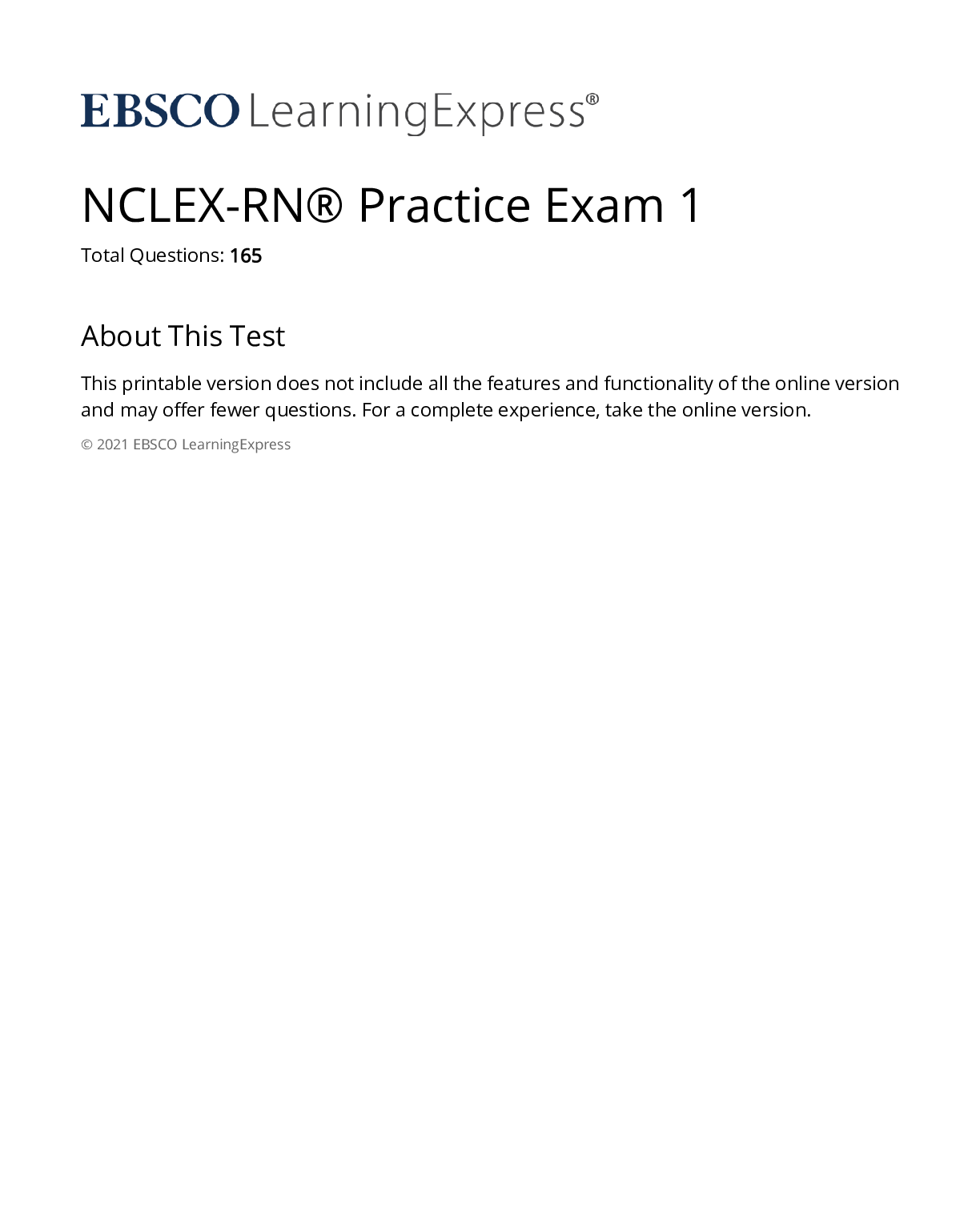
Reviews( 0 )
Document information
Connected school, study & course
About the document
Uploaded On
May 02, 2022
Number of pages
60
Written in
Additional information
This document has been written for:
Uploaded
May 02, 2022
Downloads
2
Views
127


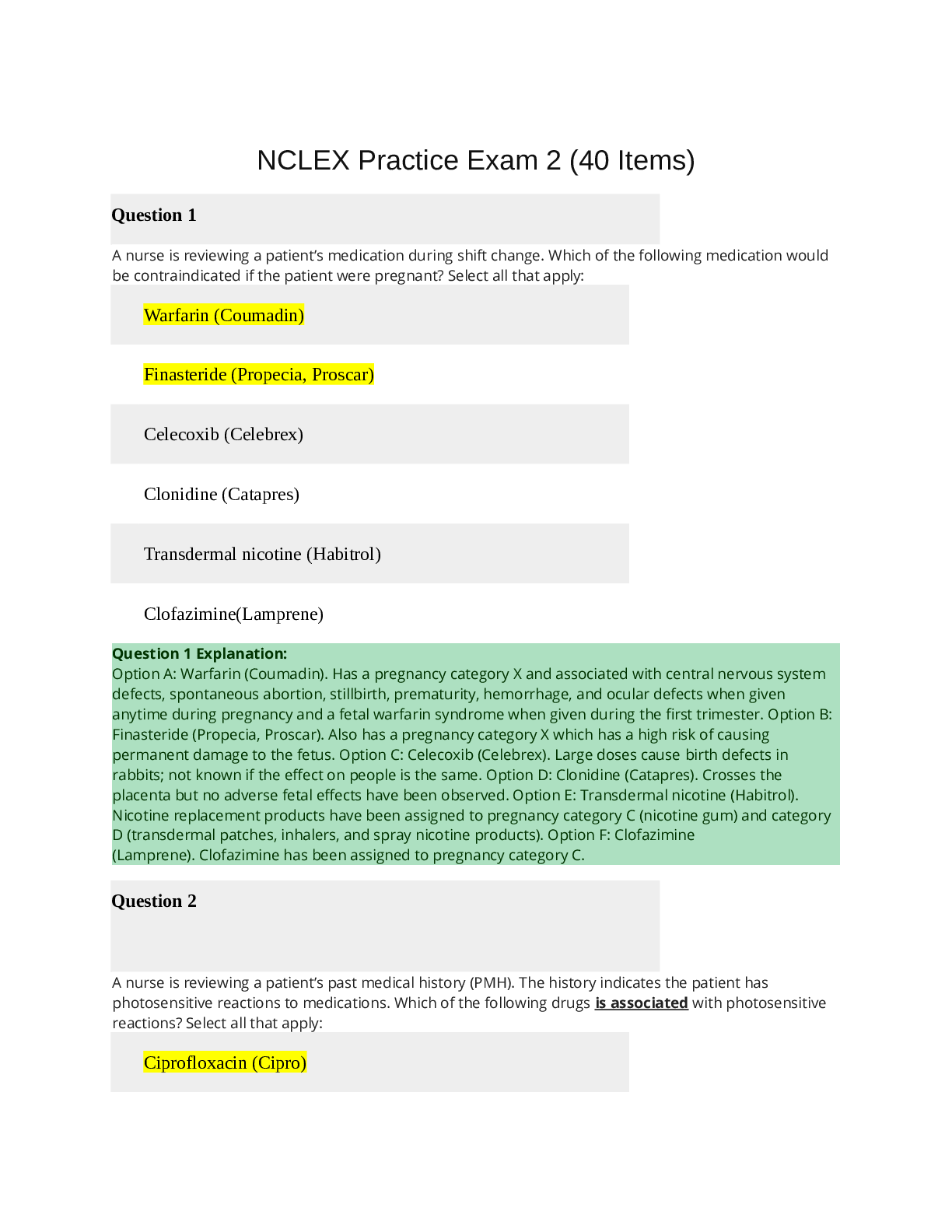
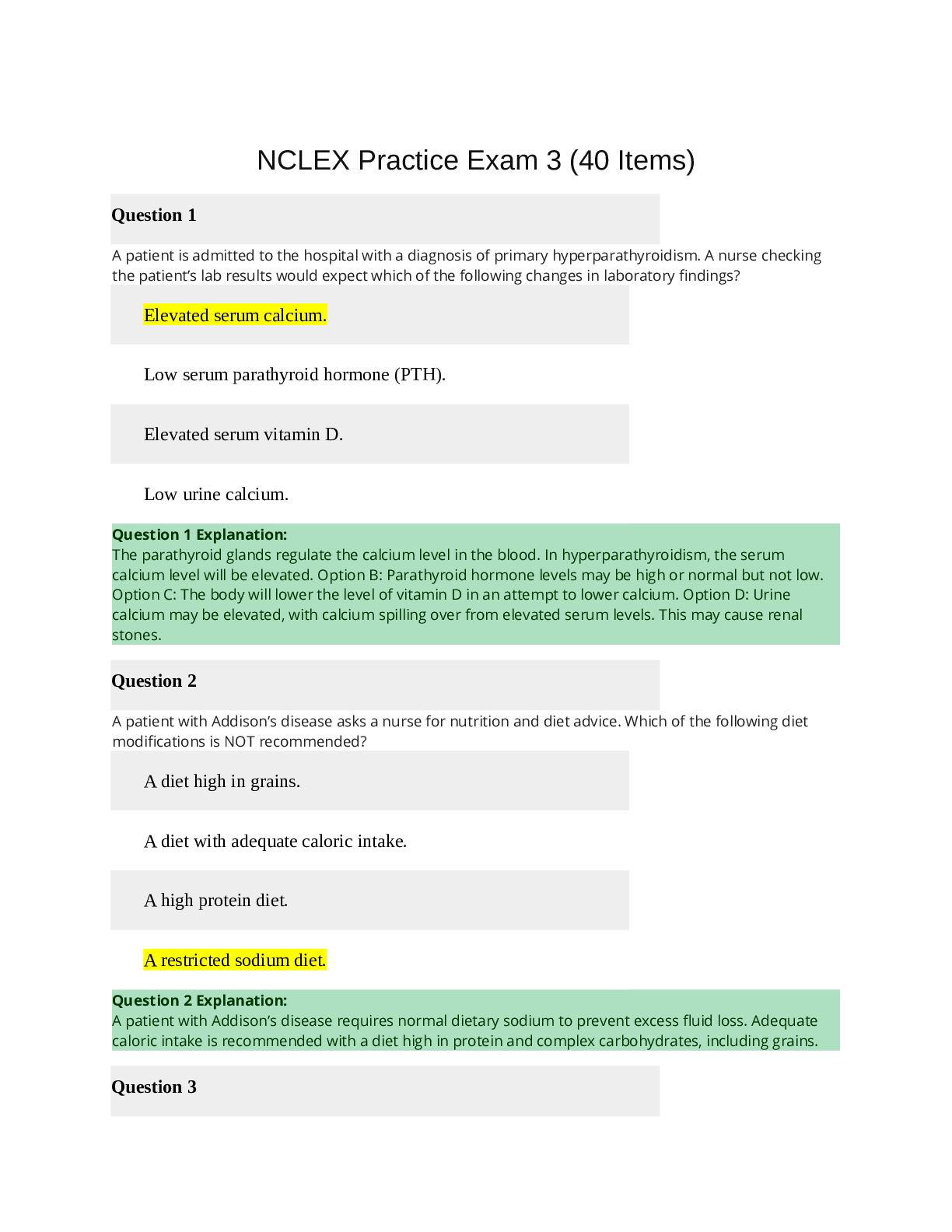
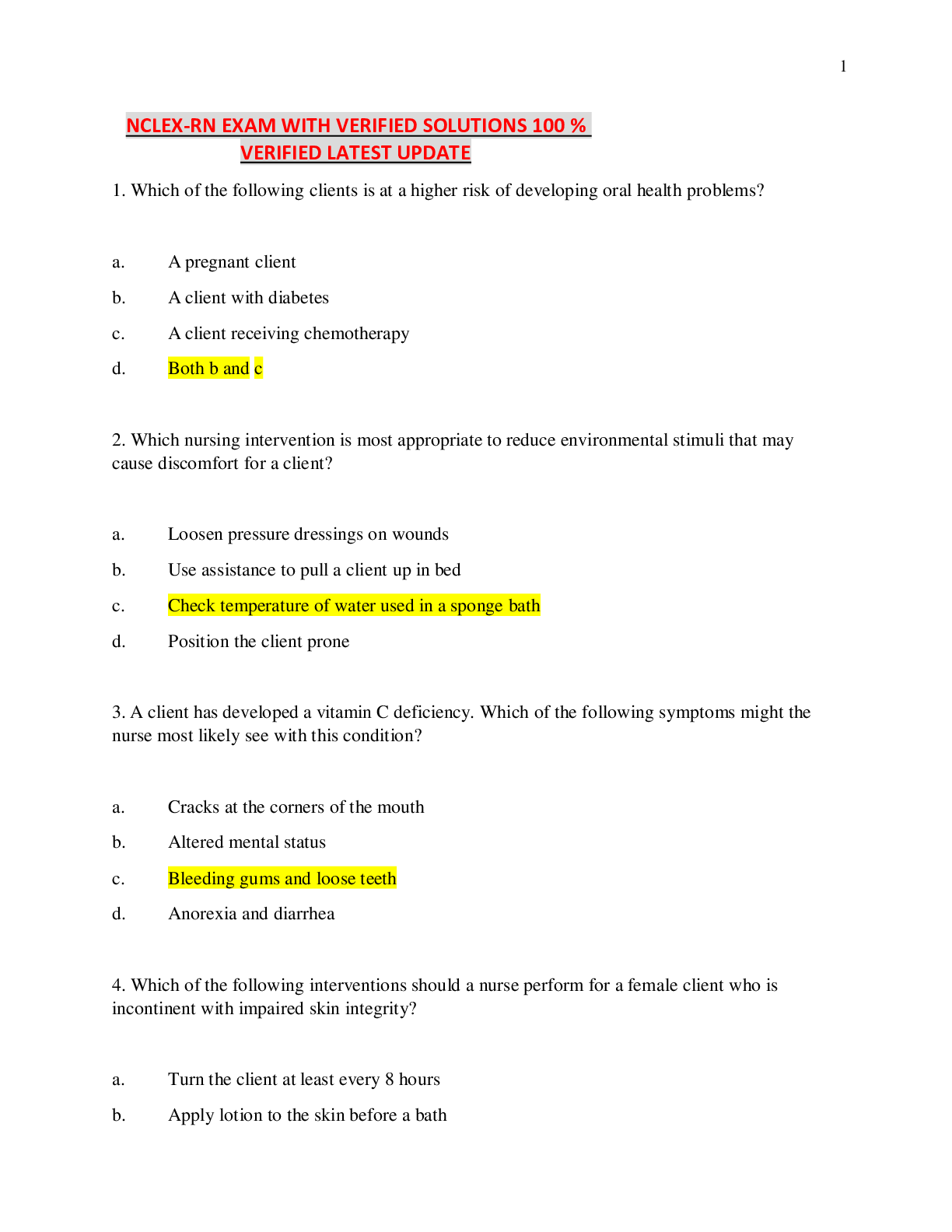

 (1).png)

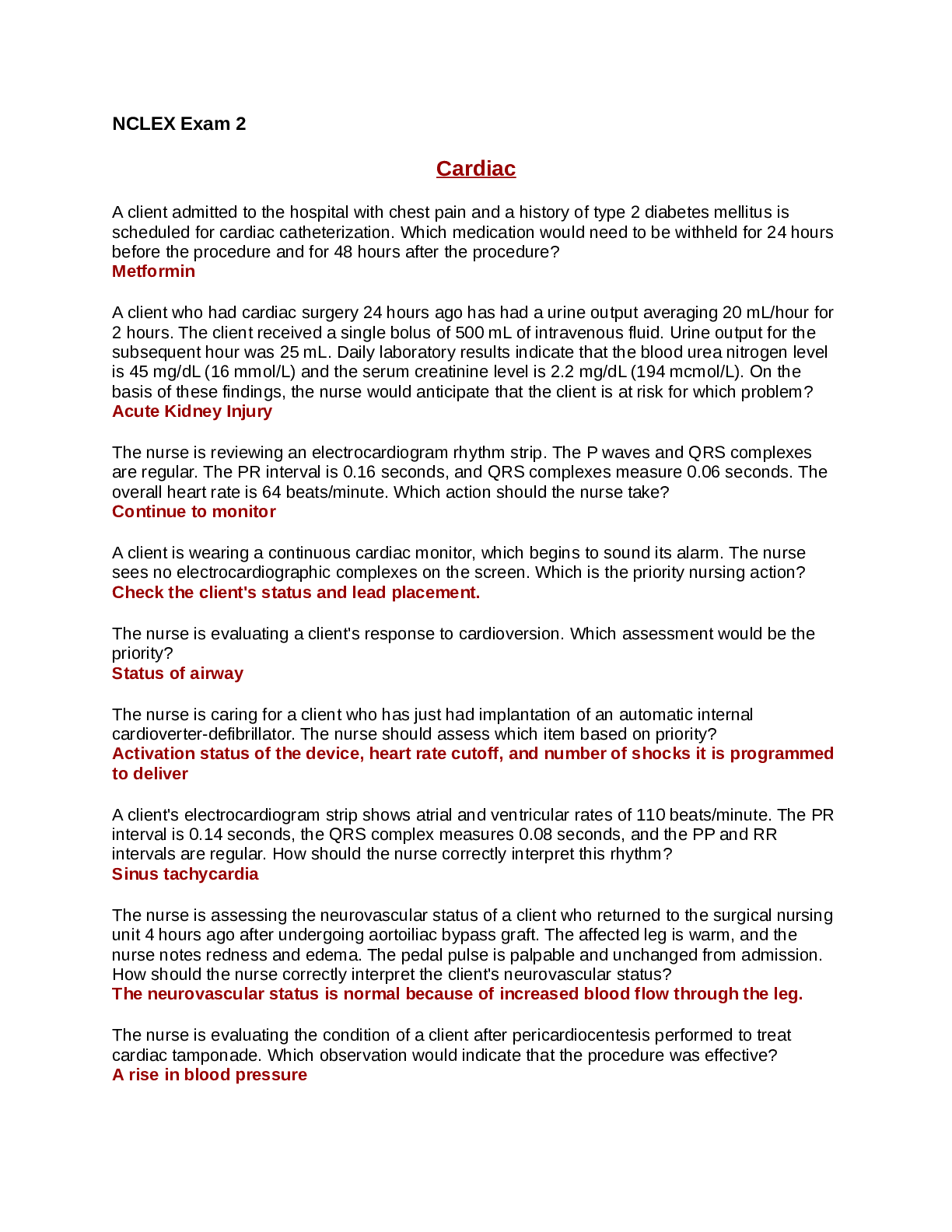
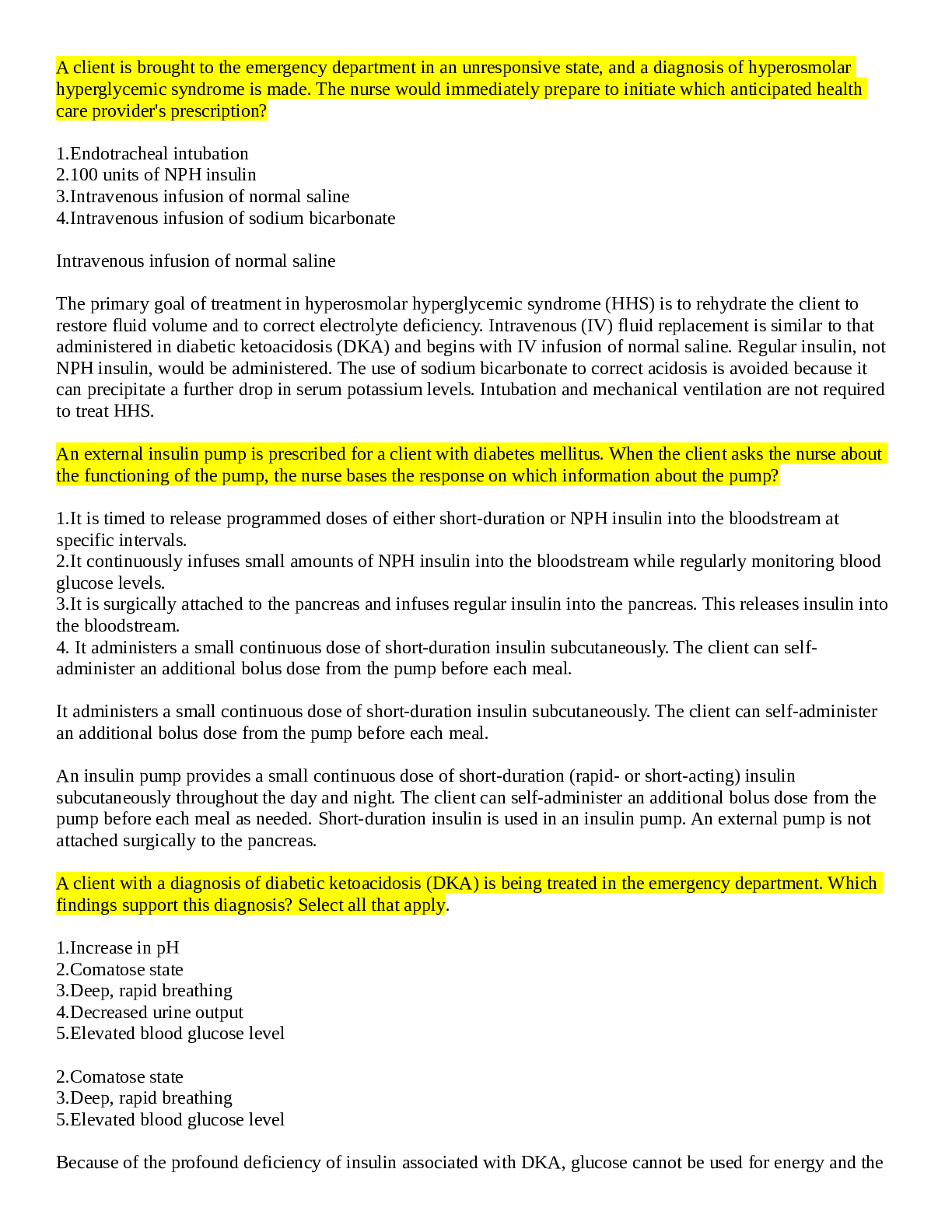
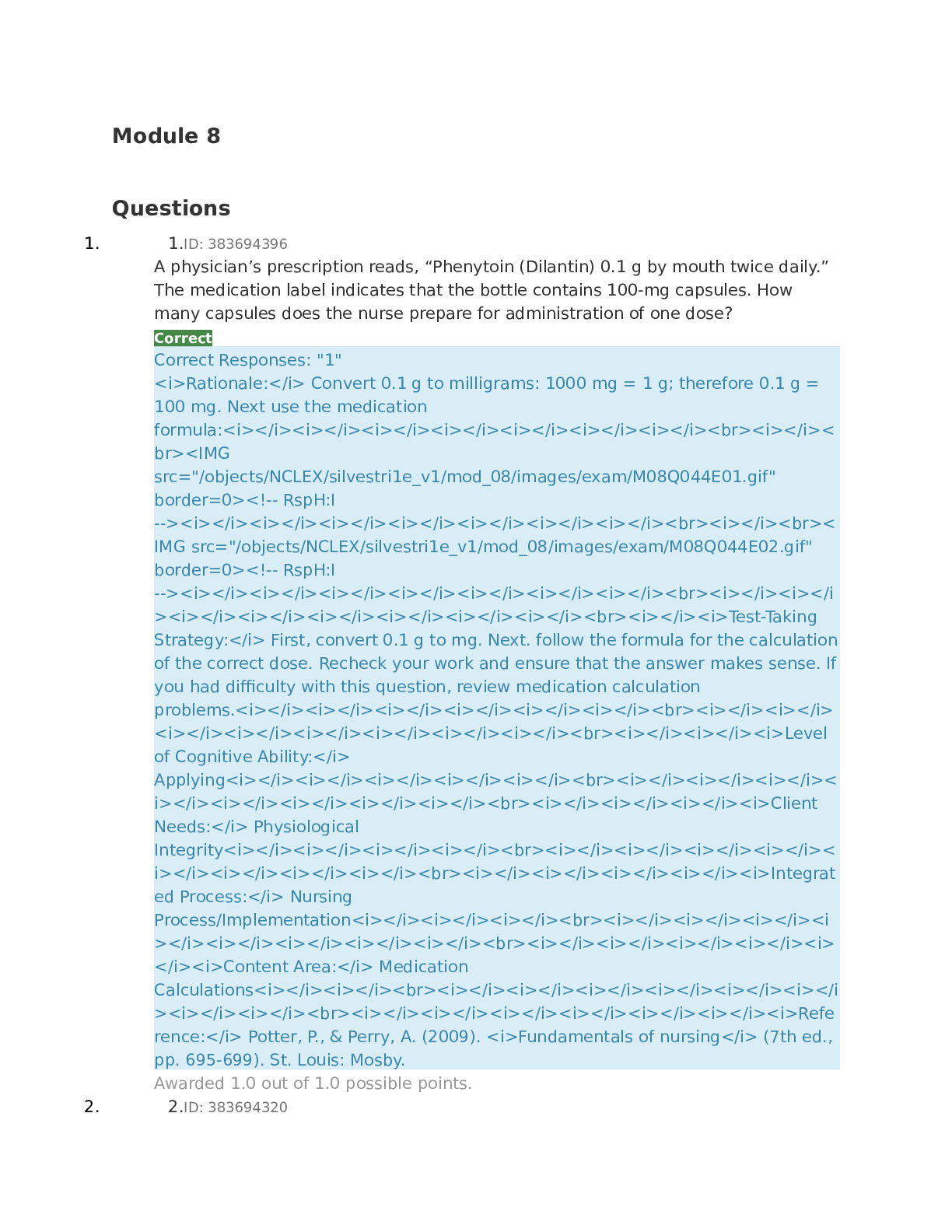
.png)
.png)

